English gardens represent the pinnacle of timeless landscape design, blending natural beauty with refined structure to create outdoor spaces that feel both elegant and welcoming. These enchanting landscapes have evolved over centuries, from the practical cottage gardens of medieval times to the grand estate gardens of the Victorian era. What makes English garden design so enduring is its perfect balance between formal elements and natural charm. Whether you have a small courtyard or sprawling acreage, English garden principles can transform any space into a romantic retreat. The style embraces layers of texture, seasonal interest, and the artful combination of flowers, shrubs, and architectural features. From rose-covered pergolas to boxwood-lined pathways, these designs celebrate both beauty and functionality while creating havens that invite exploration and peaceful contemplation.
1. Traditional Cottage Garden Border
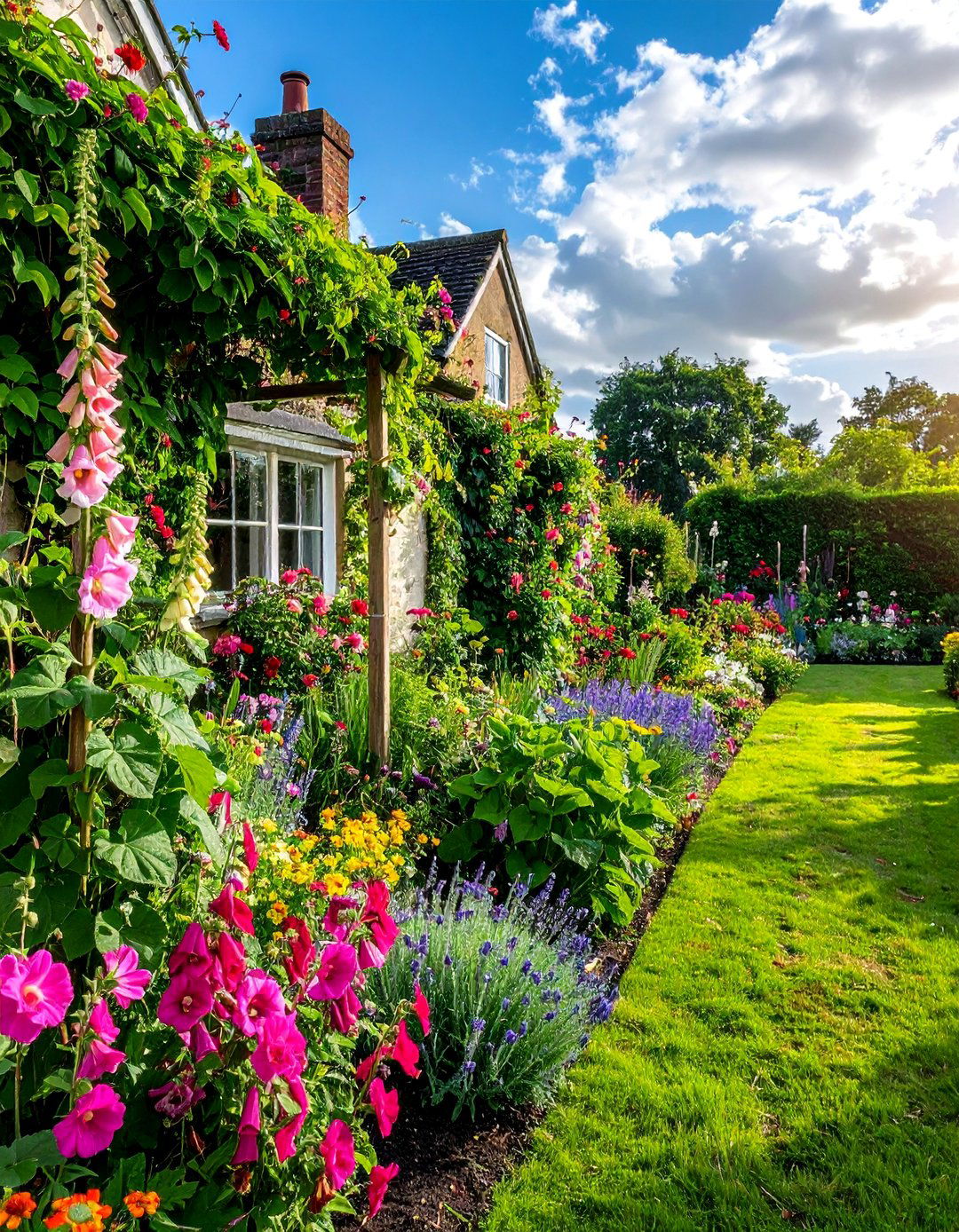
The traditional cottage garden border captures the essence of English countryside charm with its informal, abundant plantings that appear naturally wild yet are thoughtfully planned. This design features a delightful mix of perennials, annuals, herbs, and vegetables all growing together in joyful profusion. Plant hollyhocks against walls, allowing sweet peas to climb wooden supports while roses spill over rustic fences. Fill the middle ground with foxgloves, delphiniums, and peonies, then edge with lavender, catmint, and herbs. The secret lies in layering plants by height and allowing them to self-seed naturally. Include practical elements like fruit bushes and vegetables among the flowers, staying true to the original cottage garden purpose. The overall effect should feel slightly wild and overgrown, with plants mingling freely and paths barely visible beneath cascading blooms.
2. Formal Boxwood Parterre Design
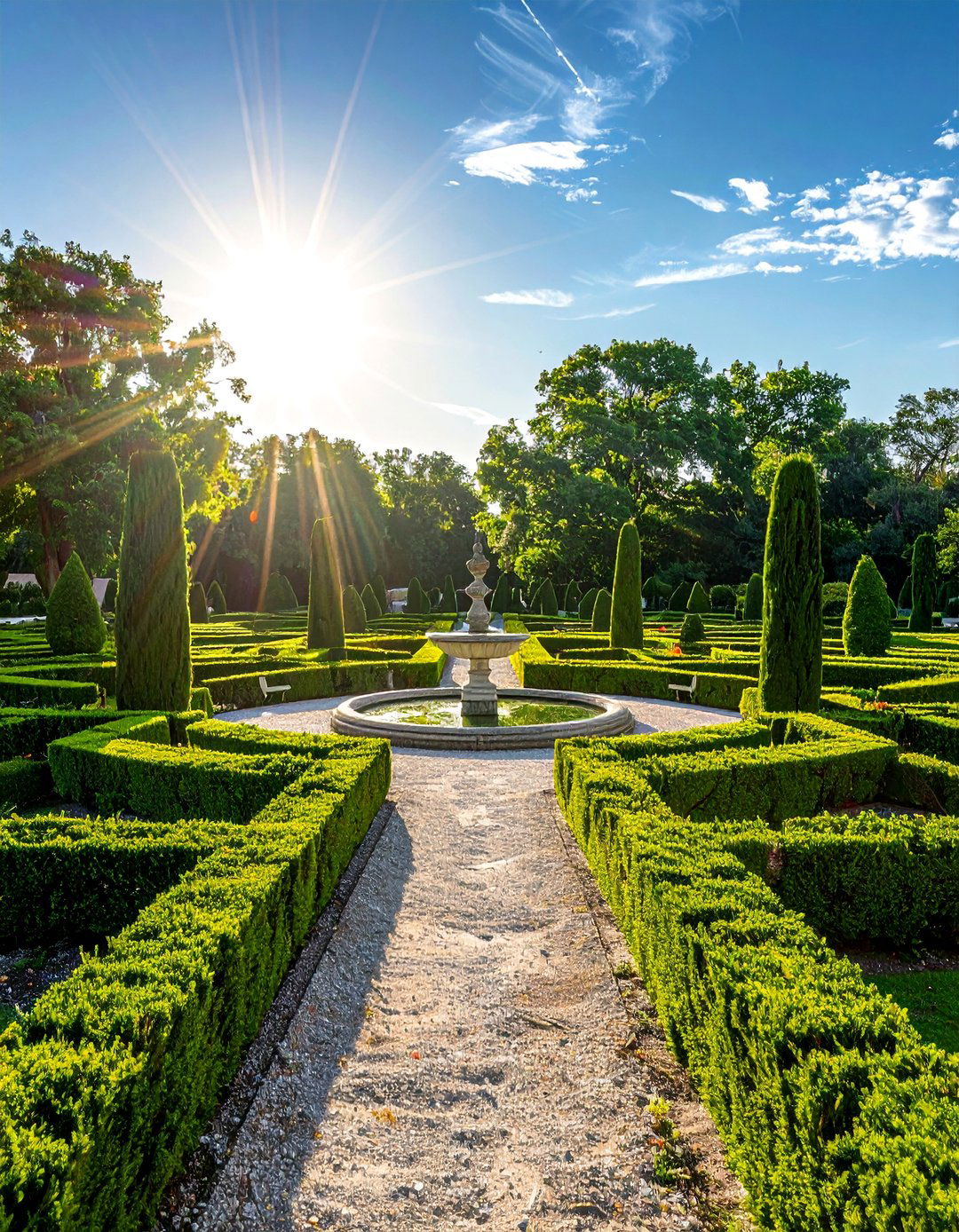
Create a sophisticated formal garden using precisely clipped boxwood hedges arranged in geometric patterns that form elegant parterres reminiscent of grand English estates. This structured approach uses low boxwood borders to define symmetrical planting beds, often arranged around a central focal point like a fountain or sundial. Fill the enclosed spaces with seasonal plantings of herbs, roses, or colorful annuals that contrast beautifully with the evergreen framework. The key is maintaining crisp, clean lines through regular trimming and ensuring perfect symmetry in your layout. Gravel or brick pathways should connect the various sections, creating a sense of order and grandeur. This design works particularly well in front gardens or courtyards where the formal structure complements architectural features. The year-round structure provided by boxwood ensures the garden remains attractive even in winter months.
3. English Rose Garden Room
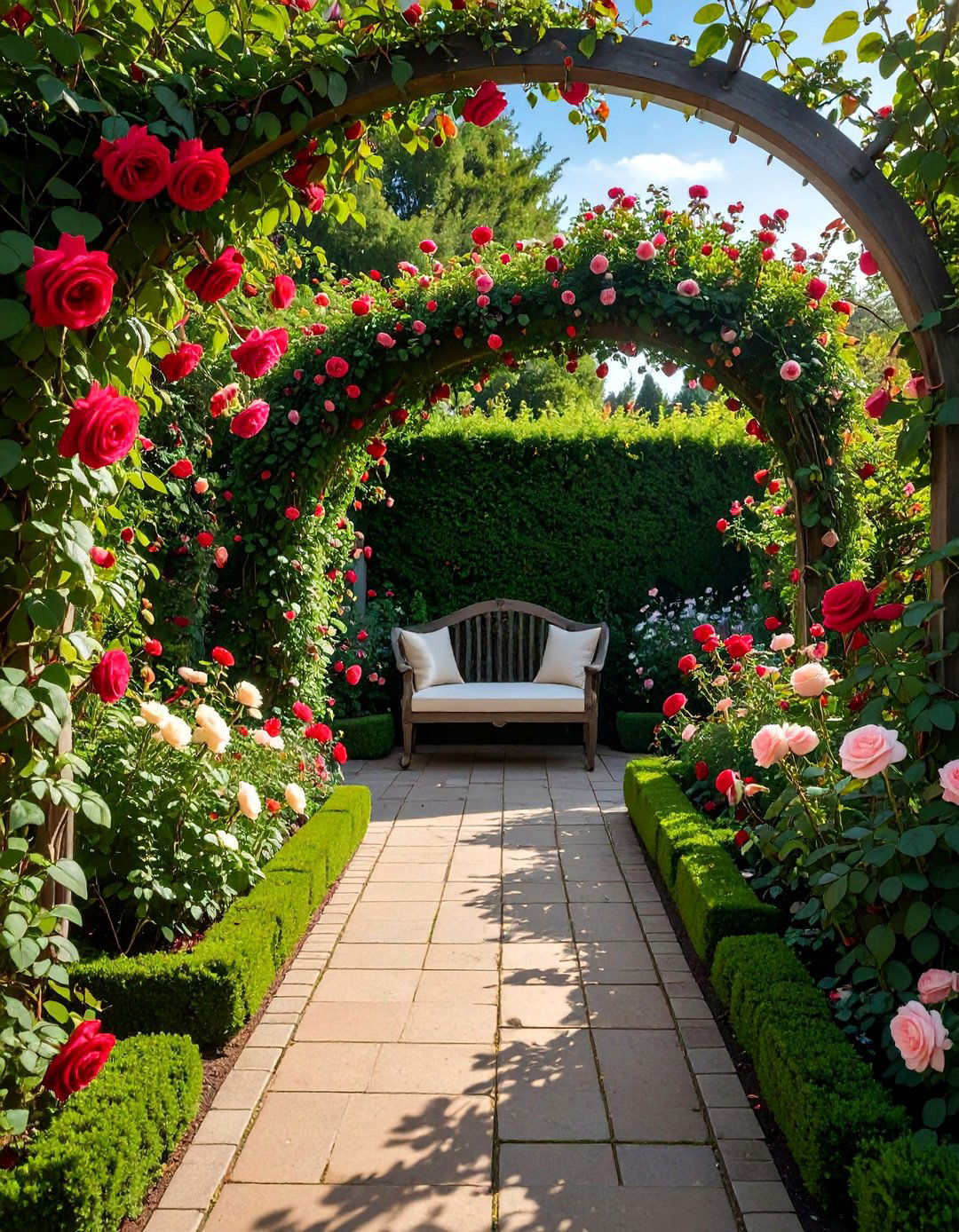
Design a dedicated rose garden room enclosed by hedges or walls that showcases the queen of flowers in all her glory. This intimate space should feature a careful selection of English roses, climbing varieties, and historic varieties arranged for continuous bloom throughout the season. Include David Austin roses for their exceptional fragrance and old-fashioned charm, paired with classic hybrid teas and floribundas. Create height with rose-covered arches, obelisks, and pergolas while using lower shrub roses to fill borders. Underplant with complementary perennials like lavender, catmint, and hardy geraniums that enhance rather than compete with the roses. Incorporate seating areas where visitors can pause to enjoy the intoxicating fragrances. The enclosure creates a microclimate that protects the roses while intensifying their perfume, making this space feel like a secret garden sanctuary.
4. Woodland Shade Garden
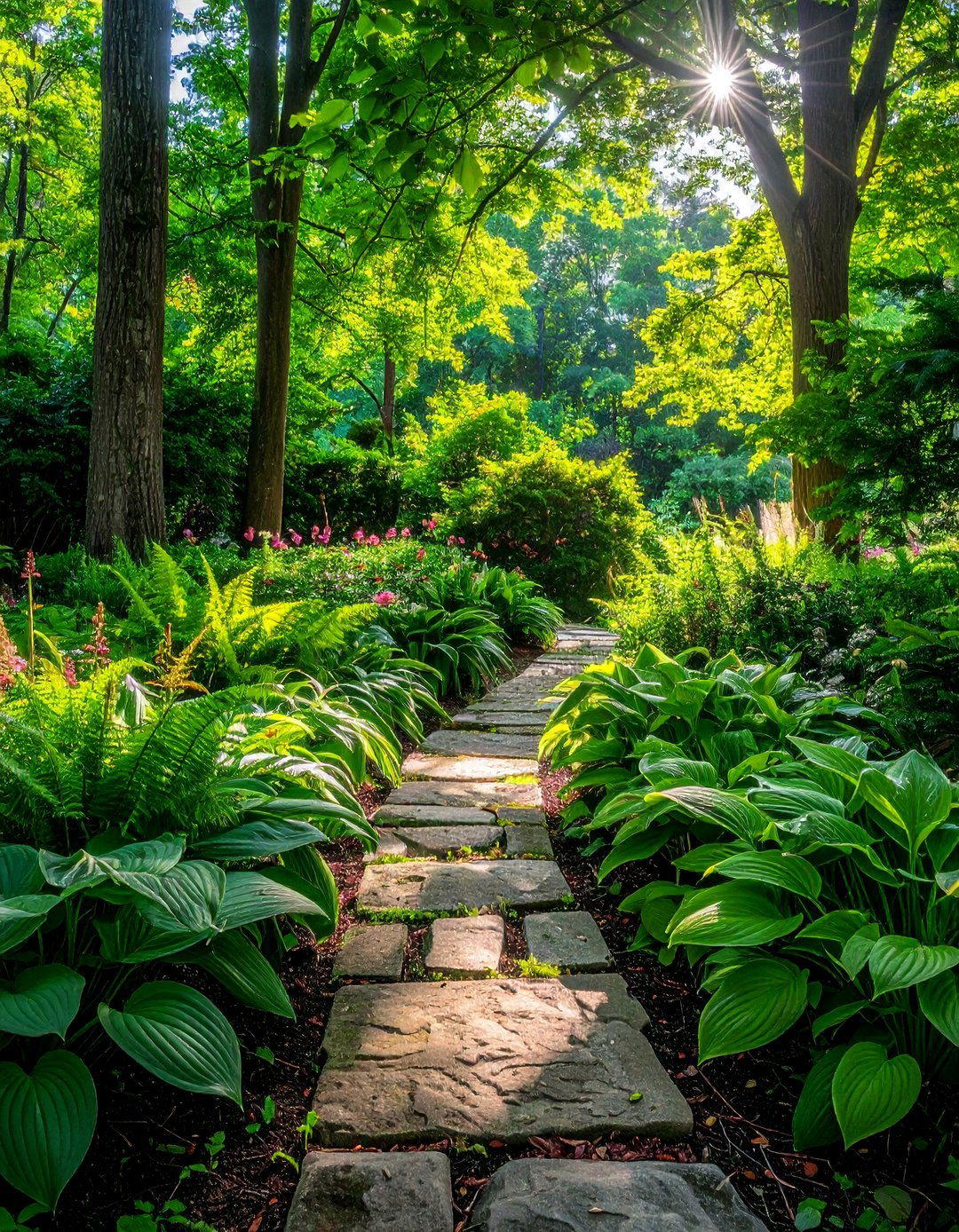
Transform a shaded area into an enchanting woodland garden that celebrates the beauty of dappled light and lush foliage plants. This design mimics natural forest understory conditions using layers of canopy trees, understory shrubs, and ground-covering perennials. Plant moisture-loving species like hostas, ferns, astilbe, and woodland wildflowers beneath existing trees or newly planted specimens. Create meandering pathways using natural materials like bark chips or flagstone that wind through the space, discovering hidden treasures like garden sculptures or rustic benches. Include early spring bulbs like bluebells, daffodils, and snowdrops that naturalize under deciduous trees, providing color before the canopy leafs out. The gentle sound of a small water feature adds tranquility to this peaceful retreat. This garden type requires minimal maintenance once established and provides a cool refuge during hot summer months.
5. Kitchen Herb Garden Paradise
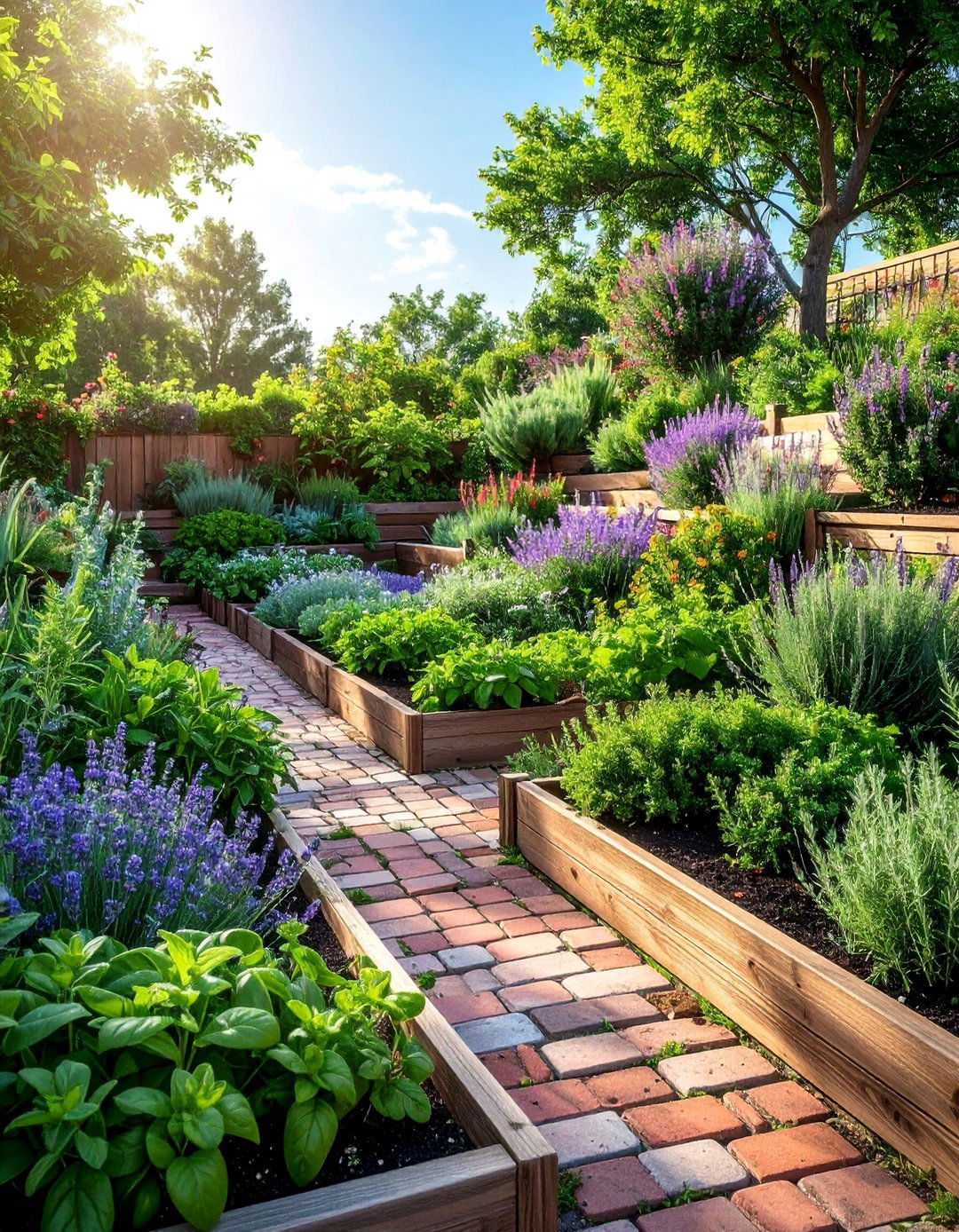
Establish a dedicated herb garden that combines culinary functionality with ornamental beauty, following the English tradition of blending practical and pretty plantings. Design raised beds or defined areas for different herb families, grouping Mediterranean herbs like rosemary, thyme, and oregano in sunny, well-draining spots. Create a more formal pattern using traditional English herbs such as parsley, chives, sage, and mint contained within low borders. Include fragrant herbs like lavender and sweet woodruff that release their scents when brushed against. Design pathways wide enough for comfortable harvesting and maintenance access, using materials like brick or gravel that complement the garden's style. Add vertical elements with herb-covered obelisks or trellises supporting climbing varieties. This garden should be positioned close to the kitchen for convenient daily use while maintaining year-round interest through both evergreen and deciduous plantings.
6. Water Garden Sanctuary
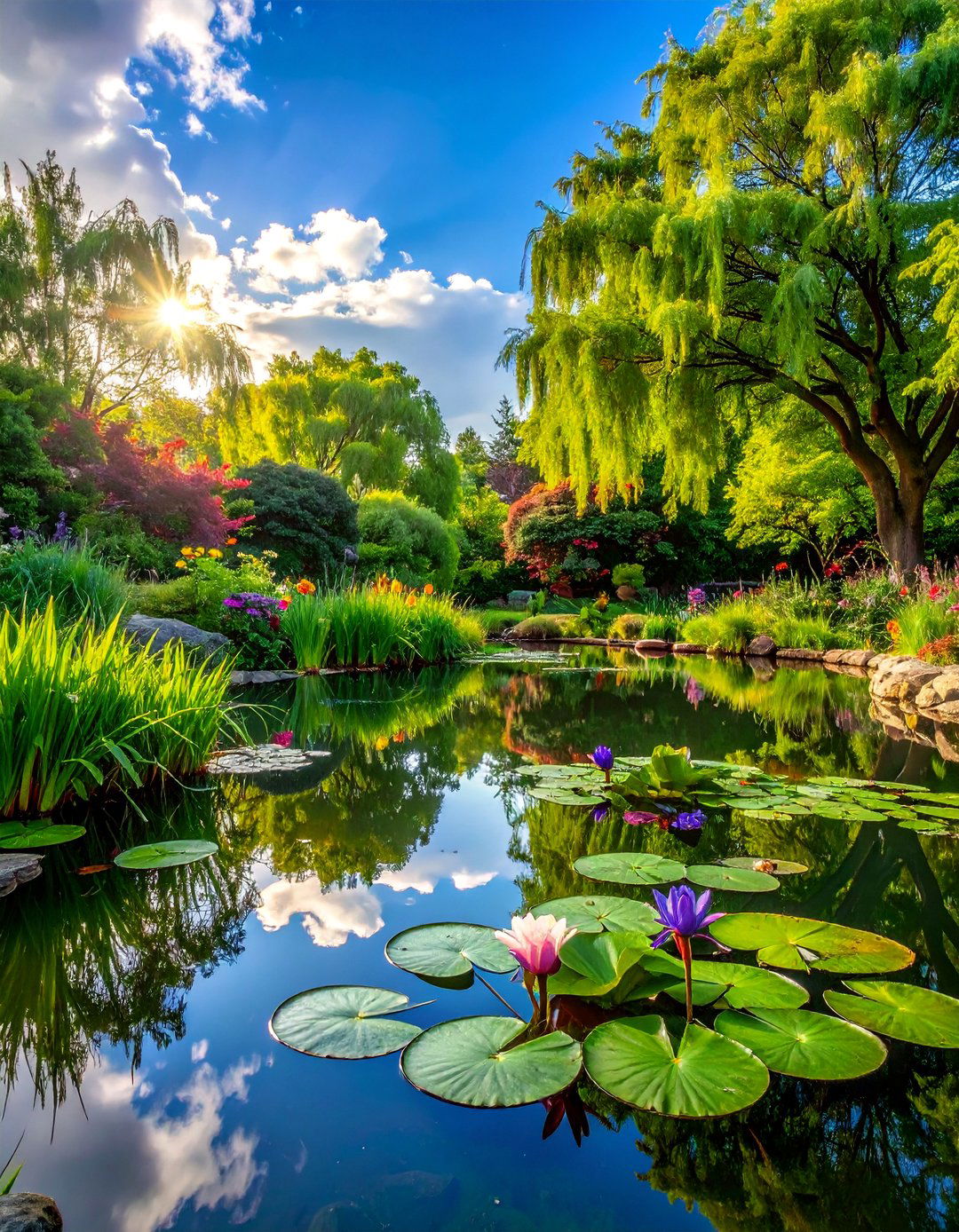
Create a tranquil water garden featuring a naturalistic pond surrounded by moisture-loving plants that reflects the English love of water in landscape design. Position the pond to catch reflections of sky and surrounding plantings while incorporating gentle water movement through a small fountain or cascade. Plant the margins with classic English water plants like water lilies, iris, and marsh marigolds, creating natural-looking edges that blend seamlessly with the surrounding garden. Include a variety of heights and textures using astilbe, ligularia, and ornamental grasses that thrive in moist conditions. Design seating areas nearby where visitors can enjoy the peaceful sounds of water and observe wildlife that the feature attracts. The pond should feel like a natural part of the landscape rather than an imposed feature, with curved edges and varied depths that support both plants and wildlife while providing year-round beauty.
7. Wildflower Meadow Haven
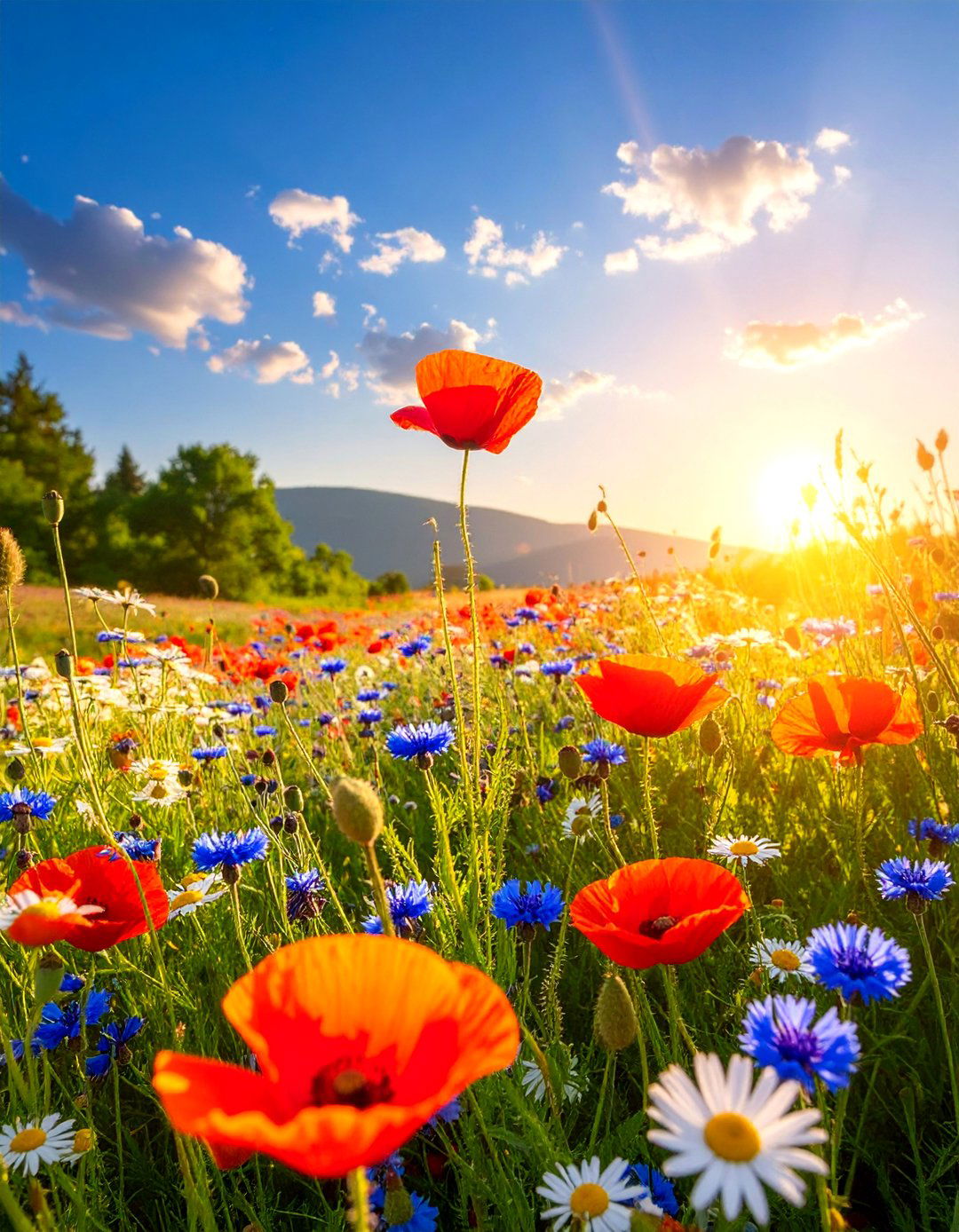
Transform a sunny area into a naturalistic wildflower meadow that captures the romance of English countryside while providing valuable habitat for pollinators and wildlife. Select native wildflower seeds suited to your climate that will create waves of seasonal color throughout the growing season. Include classic English meadow flowers like poppies, cornflowers, ox-eye daisies, and wild carrot that self-seed and naturalize over time. Create flowing edges that blend into more formal garden areas while maintaining pathways for access and viewing. This low-maintenance approach requires minimal intervention once established, with annual cutting in late winter to encourage fresh growth. The changing tapestry of colors and textures throughout the seasons provides dynamic interest while supporting local ecosystem health. Consider incorporating ornamental grasses that add winter structure and movement while providing seed for birds during colder months.
8. Potager Vegetable Garden
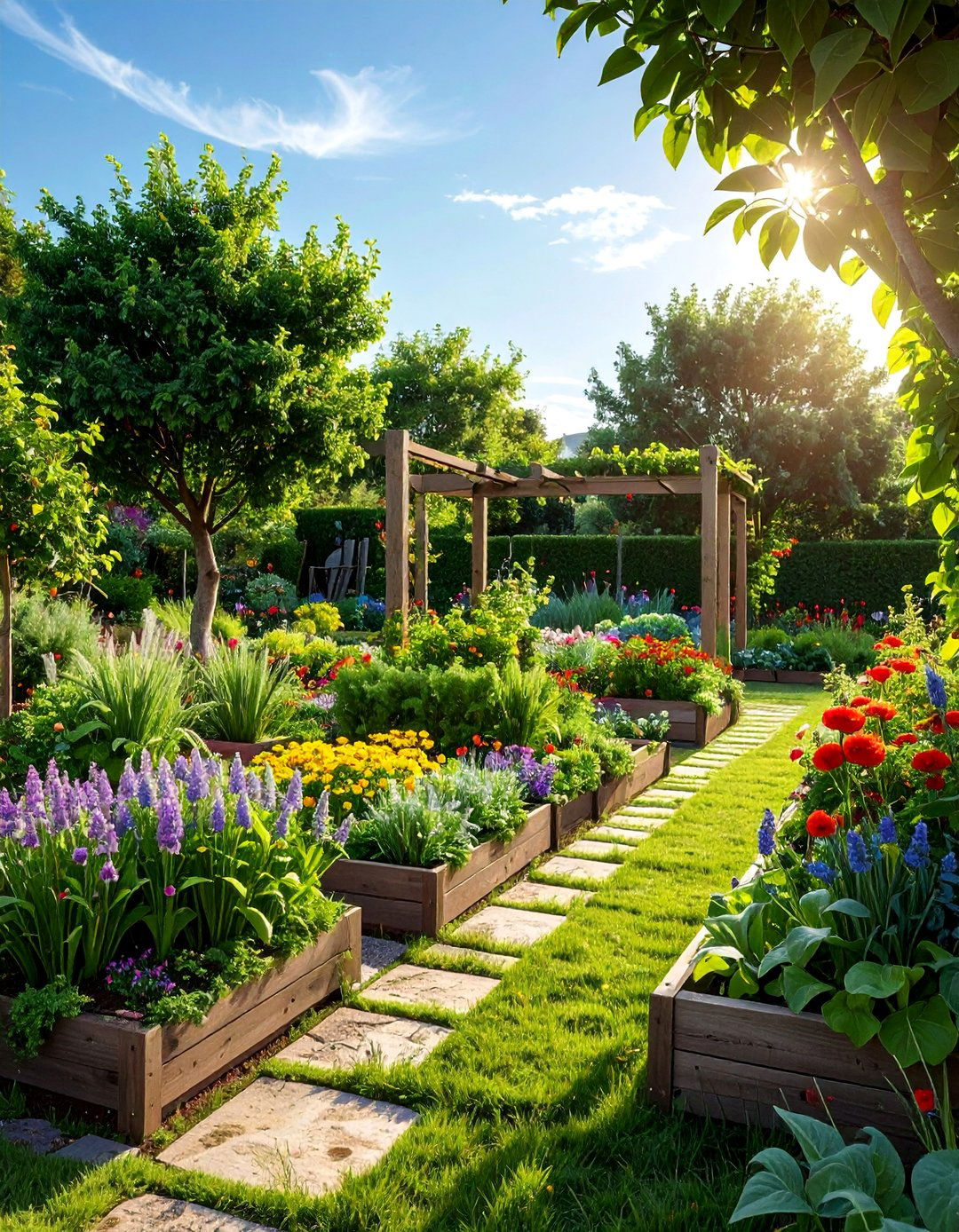
Design an ornamental kitchen garden or potager that elevates vegetable growing into an art form through careful attention to layout, plant combinations, and seasonal succession. Create geometric beds separated by permanent pathways that allow easy access for maintenance and harvesting while providing year-round structure. Mix vegetables with herbs and edible flowers to create beautiful color combinations and beneficial companion plantings. Include vertical elements like bean poles, tomato cages, and fruit trees that add height and support climbing crops. Plan for continuous harvest by succession planting and including crops with different harvest times and growth habits. The beds should remain attractive even when not fully planted through the use of permanent edging, quality pathways, and structural plants. This design celebrates the beauty inherent in productive plants while providing fresh food for the table throughout the growing season.
9. Climbing Rose Pergola Walkway
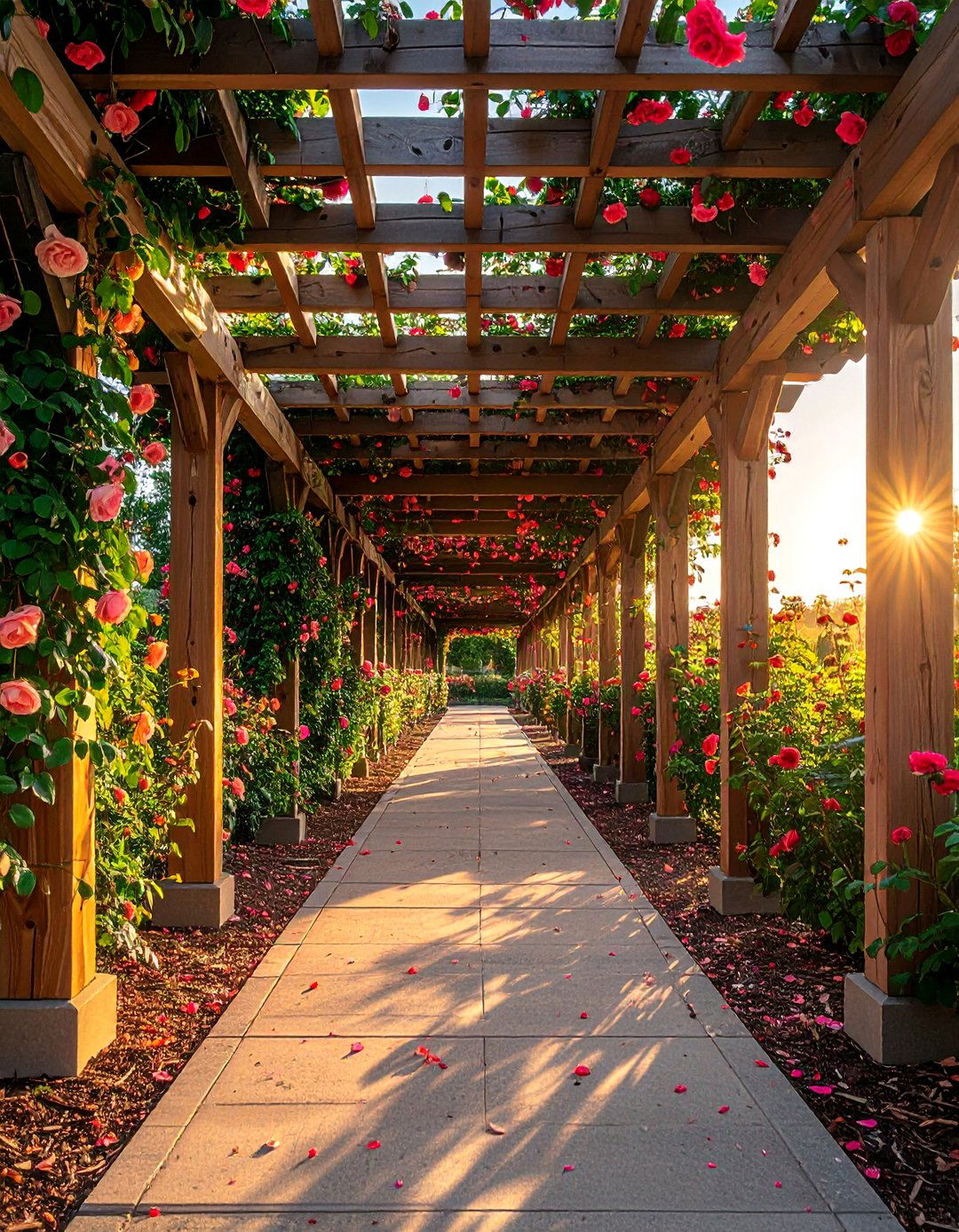
Install a substantial pergola structure that supports vigorous climbing roses, creating an enchanting walkway that provides vertical drama and seasonal fragrance. Choose roses known for their climbing ability and disease resistance, such as 'New Dawn', 'Climbing Iceberg', or English climbing varieties from David Austin. The pergola should be constructed from sturdy materials like oak or cedar that will age gracefully while supporting the weight of mature climbing roses. Train the roses carefully in their early years to ensure good coverage and flowering along the entire structure. Underplant with shade-tolerant perennials that can handle the competition from rose roots while complementing the overall design. Include seating at strategic points along the walkway where visitors can pause and enjoy the overhead canopy of blooms. This feature creates a dramatic entrance or transition between different garden areas while providing shelter and intimate scale.
10. Ornamental Grass Border
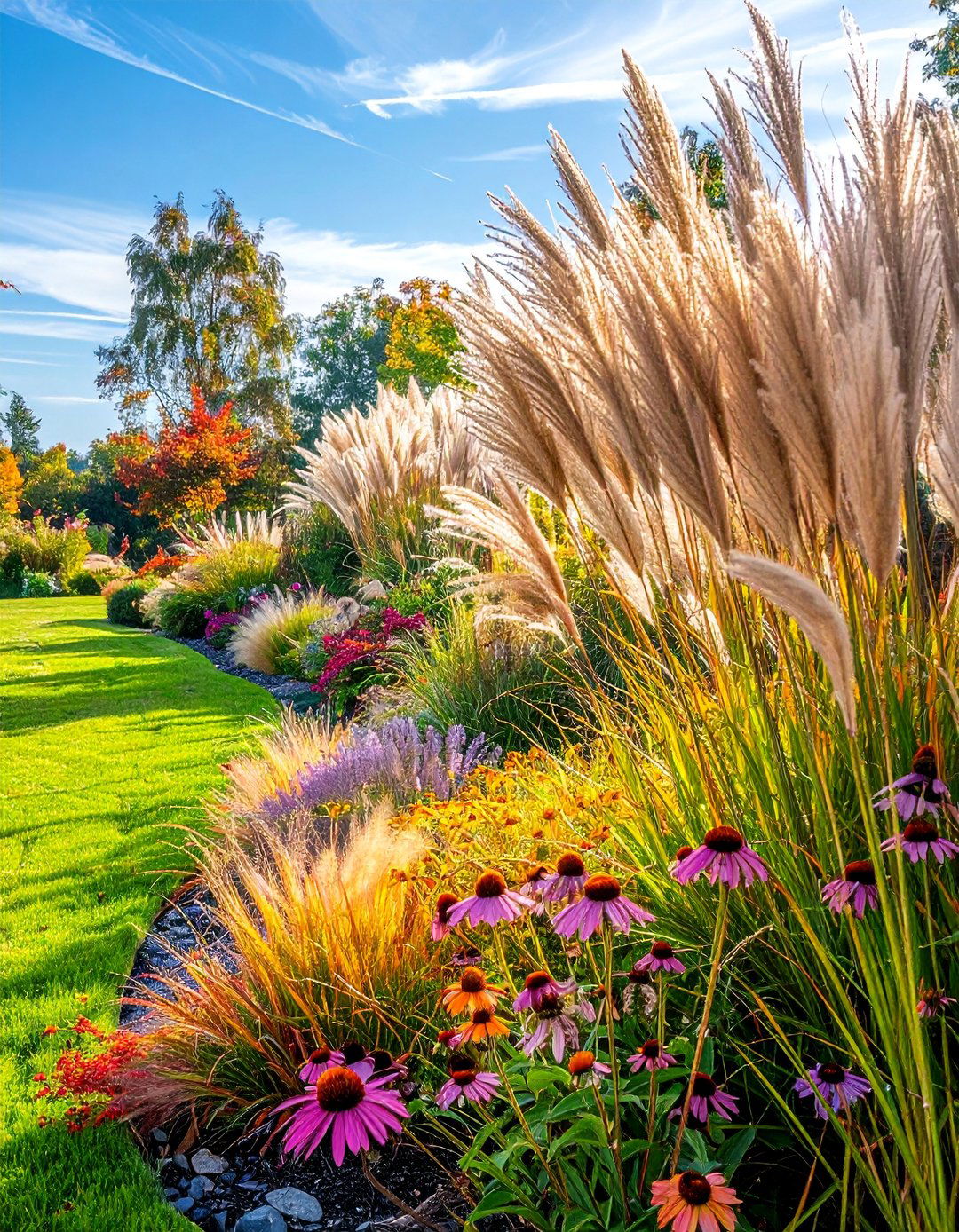
Design a contemporary border featuring ornamental grasses that provide movement, texture, and year-round interest while maintaining the natural elegance associated with English garden design. Select a variety of grass types with different heights, colors, and seasonal characteristics to create a dynamic display that changes throughout the year. Include feather reed grass for vertical accent, fountain grass for soft texture, and sedges for evergreen structure. Interplant with perennials that complement the grassy texture, such as echinacea, rudbeckia, and asters that provide color while maintaining the naturalistic feel. The border should flow and move with the slightest breeze while providing winter interest through attractive seed heads and golden or bronze winter color. This approach requires minimal maintenance while providing maximum impact throughout the seasons. Position the border where it can be backlit by morning or evening sun to highlight the translucent qualities of the grasses.
11. Formal Lavender Parterre
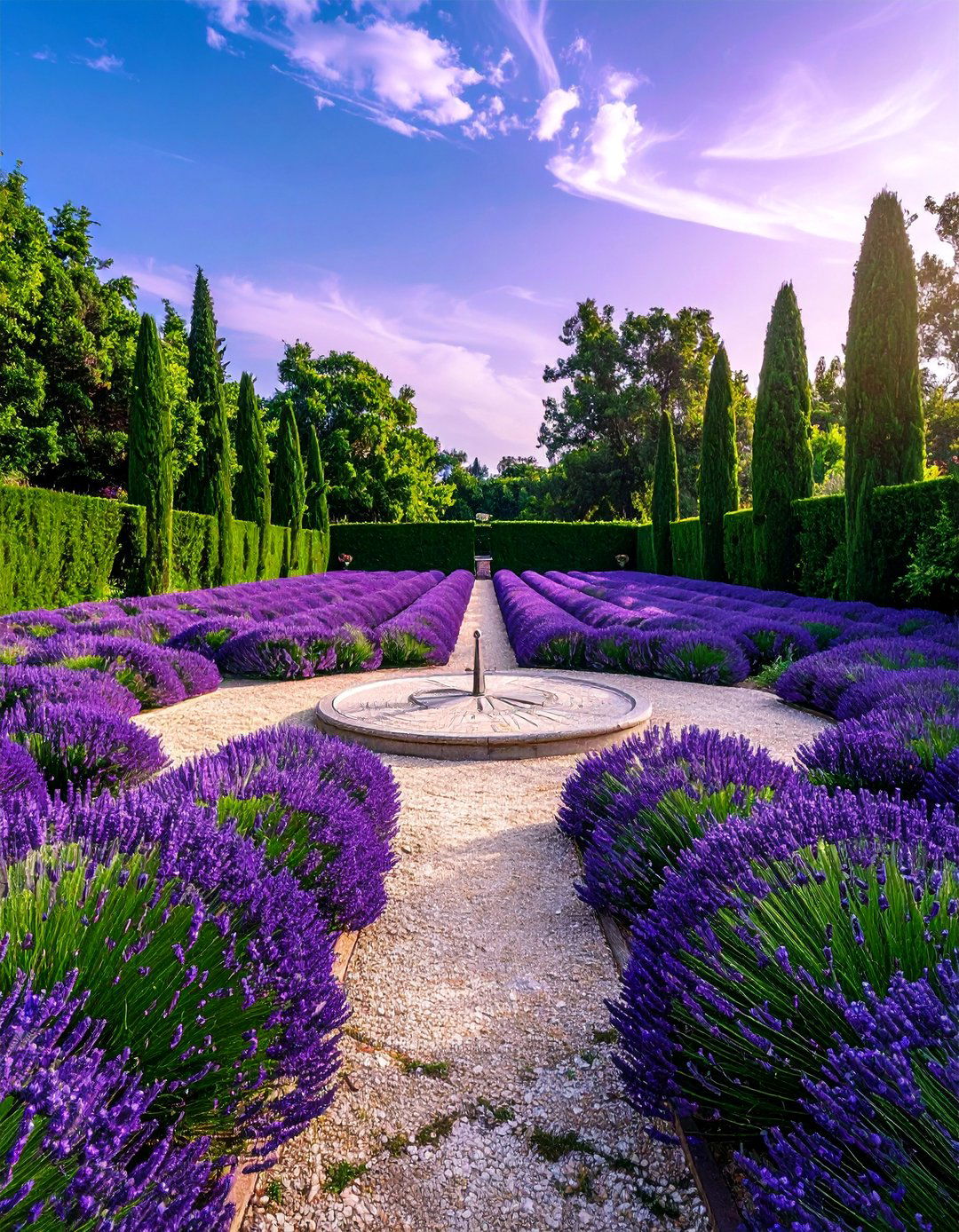
Create an aromatic formal garden using lavender as the primary structural plant, arranged in geometric patterns that provide both visual impact and practical benefits. Plant different lavender varieties to create subtle color variations from deep purple through to white, maintaining uniform heights through careful variety selection and regular pruning. Design the parterre with pathways that allow visitors to brush against the plants and release their fragrance while providing access for maintenance. Fill the spaces between lavender hedging with complementary plants like santolina, rosemary, or seasonal annuals that enhance the Mediterranean character. Include a central focal point such as a sundial, statue, or formal water feature that anchors the design. This garden type thrives in sunny, well-draining conditions while providing cut flowers, dried flowers, and essential oils for household use. The evergreen nature of lavender ensures year-round structure while the summer flowering period creates spectacular displays.
12. Spring Bulb Woodland
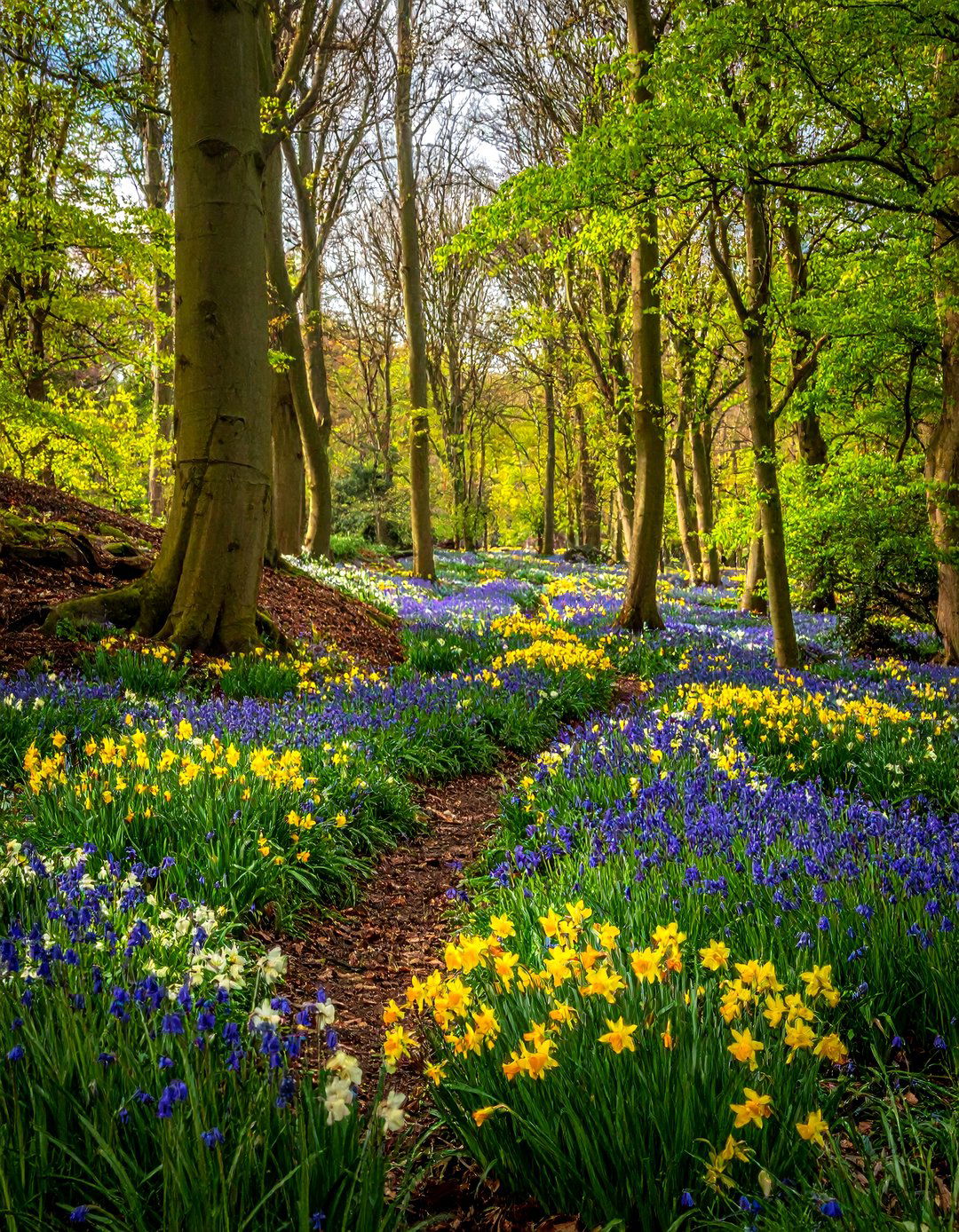
Design a specialized garden area that celebrates the glory of spring bulbs naturalized beneath deciduous trees or large shrubs, creating carpet-like displays that herald the new growing season. Plant drifts of different bulb types that flower in succession from late winter through late spring, including snowdrops, crocuses, daffodils, and bluebells. Allow the bulbs to naturalize over time, creating ever-expanding colonies that become more spectacular each year. Include early-flowering shrubs like witch hazel, forsythia, and flowering currants that provide height and additional color during the bulb season. Design pathways that wind through the plantings, allowing close appreciation of the delicate flowers while avoiding damage to emerging foliage. This garden type requires minimal maintenance once established while providing crucial early-season nectar for emerging pollinators. The temporary nature of the display makes it all the more precious and anticipated each year.
13. Topiary Garden Display
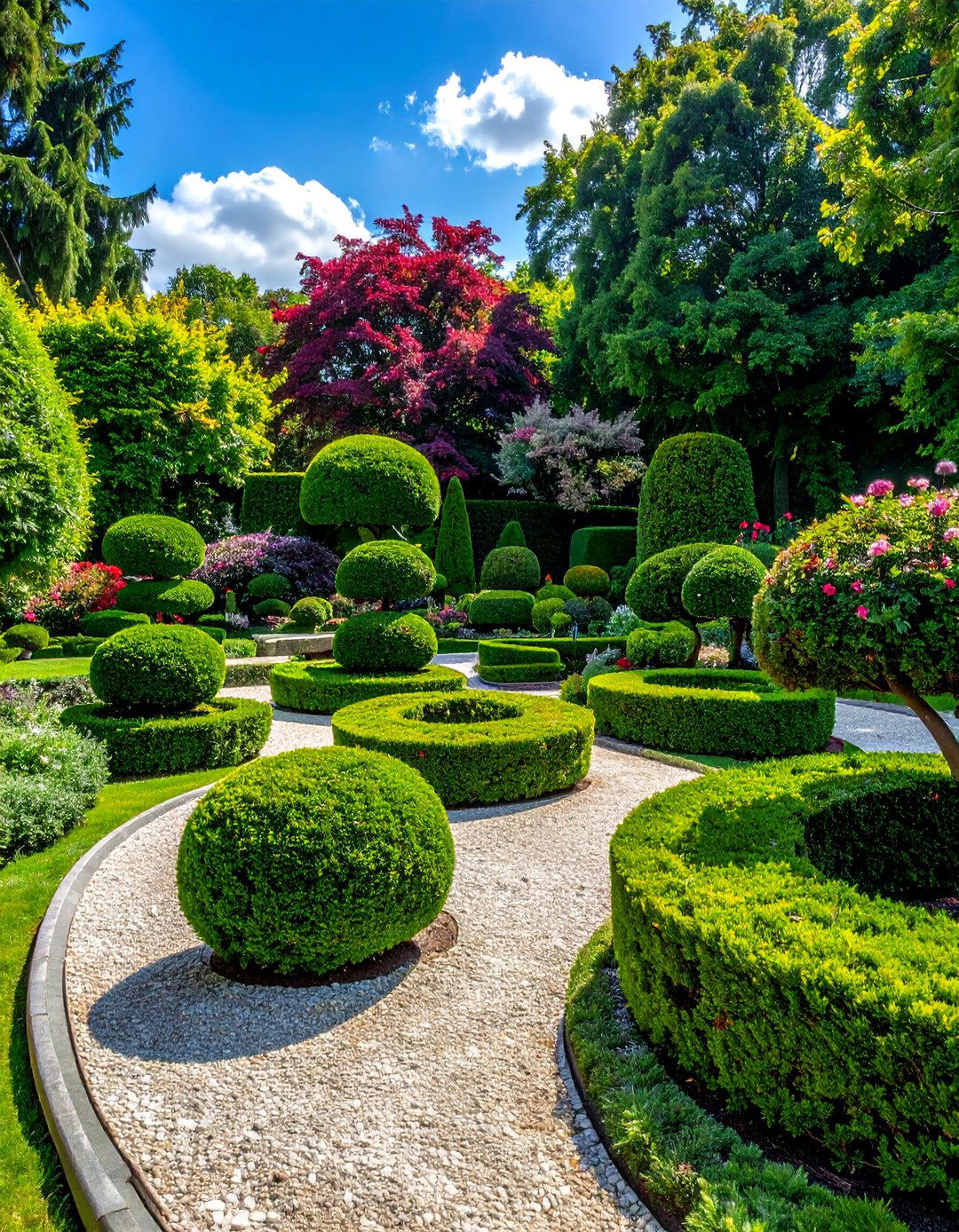
Create a sophisticated garden featuring carefully shaped topiary specimens that demonstrate the English mastery of the art of plant sculpture while providing year-round structure and interest. Use traditional topiary plants like boxwood, yew, and privet shaped into geometric forms, spirals, or whimsical animals that reflect personal taste and garden style. Arrange the topiary pieces to create rhythm and balance throughout the garden while leaving adequate space for each specimen to be appreciated individually. Include both large statement pieces and smaller accent plants that can be moved seasonally or rearranged as needed. The surrounding plantings should complement rather than compete with the topiary, using plants with simple forms and subtle colors. Regular maintenance is essential for maintaining crisp shapes and healthy growth. This garden type works particularly well in formal settings or as accent features in larger landscape designs where the sculpted plants provide contrast to more naturalistic plantings.
14. Mixed Shrub Border Foundation
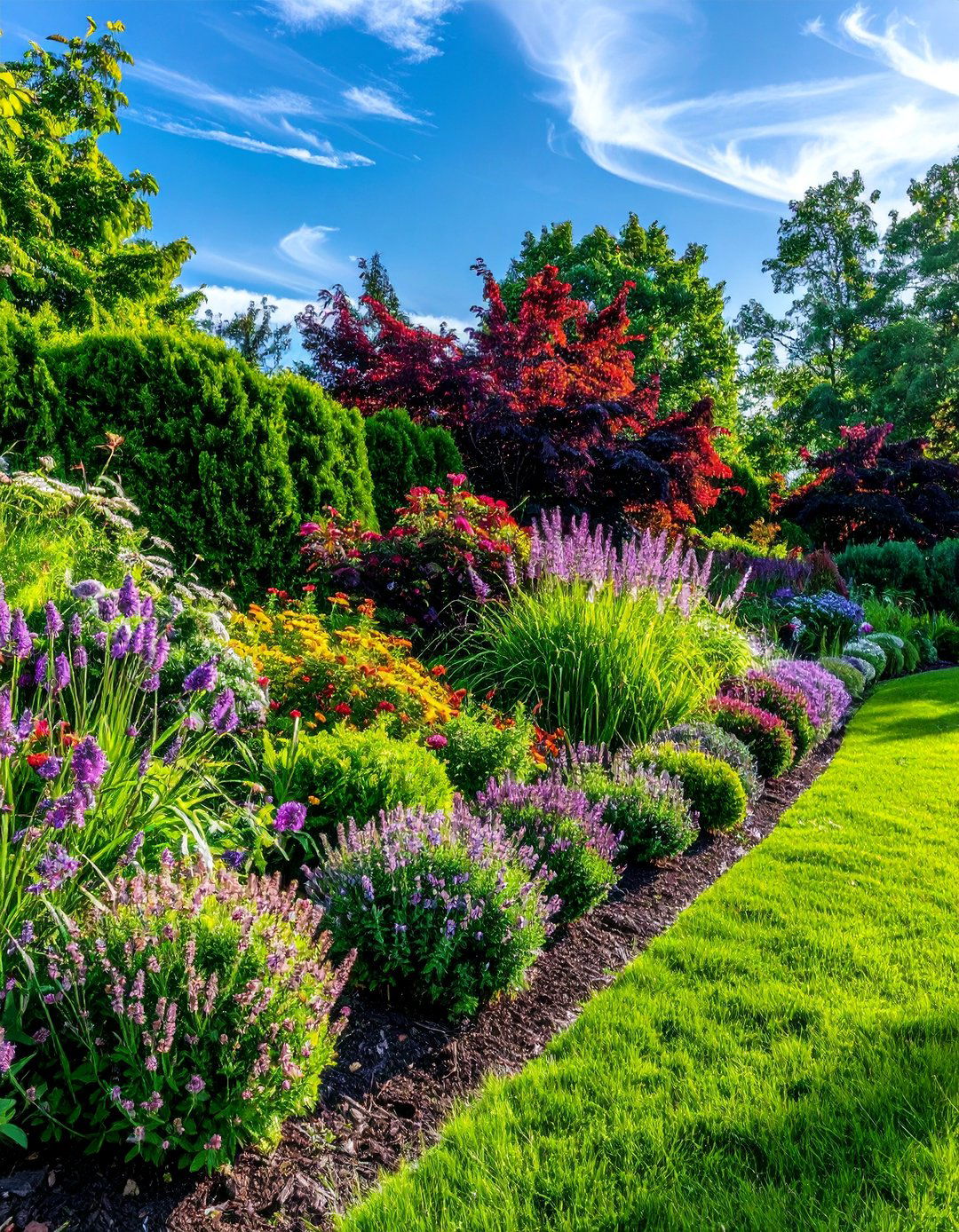
Design a substantial shrub border that provides backbone structure for the garden while featuring plants chosen for their complementary growth habits, seasonal interest, and wildlife value. Include evergreen shrubs for year-round presence, deciduous flowering shrubs for seasonal drama, and berry-producing species for autumn and winter interest. Layer the plantings by mature size with larger specimens at the back grading down to smaller plants at the front, but allow for some variation to create natural-looking groupings. Include shrubs that flower at different times to extend the season of interest while providing nectar sources for pollinators throughout the growing season. Design pathways or openings that allow access into the border for maintenance while creating viewing opportunities and intimate spaces. This type of planting requires initial planning but becomes relatively low-maintenance once established, providing excellent value for gardens of all sizes.
15. Cottage Garden Gate Entry
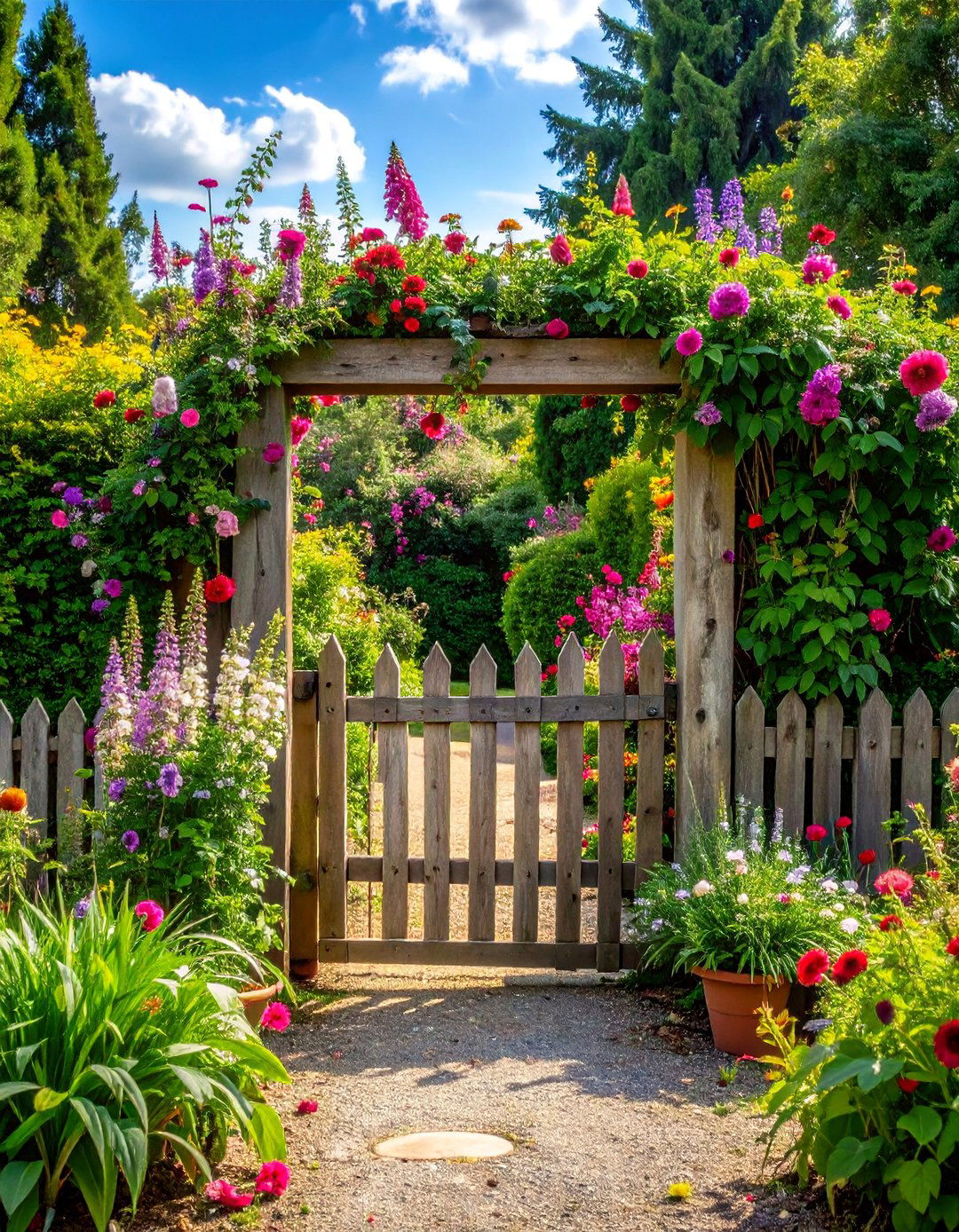
Design an enchanting entrance featuring a traditional garden gate surrounded by abundant cottage garden plantings that create a sense of anticipation and welcome for visitors. Choose a gate style that reflects the overall garden character, whether rustic wooden picket, wrought iron, or weathered timber with climbing plants. Frame the gate with fragrant plants like honeysuckle, jasmine, or climbing roses that soften the hard lines while providing seasonal interest. Include traditional cottage garden flowers on either side such as hollyhocks, foxgloves, and delphiniums that create height and color. Edge the pathway leading to the gate with low-growing perennials like catmint, hardy geraniums, or seasonal annuals that spill onto the path creating an informal, welcoming approach. The gate area should feel like a transition from the outside world into a private garden paradise, with layers of plantings that gradually reveal themselves as visitors approach.
16. Walled Kitchen Garden
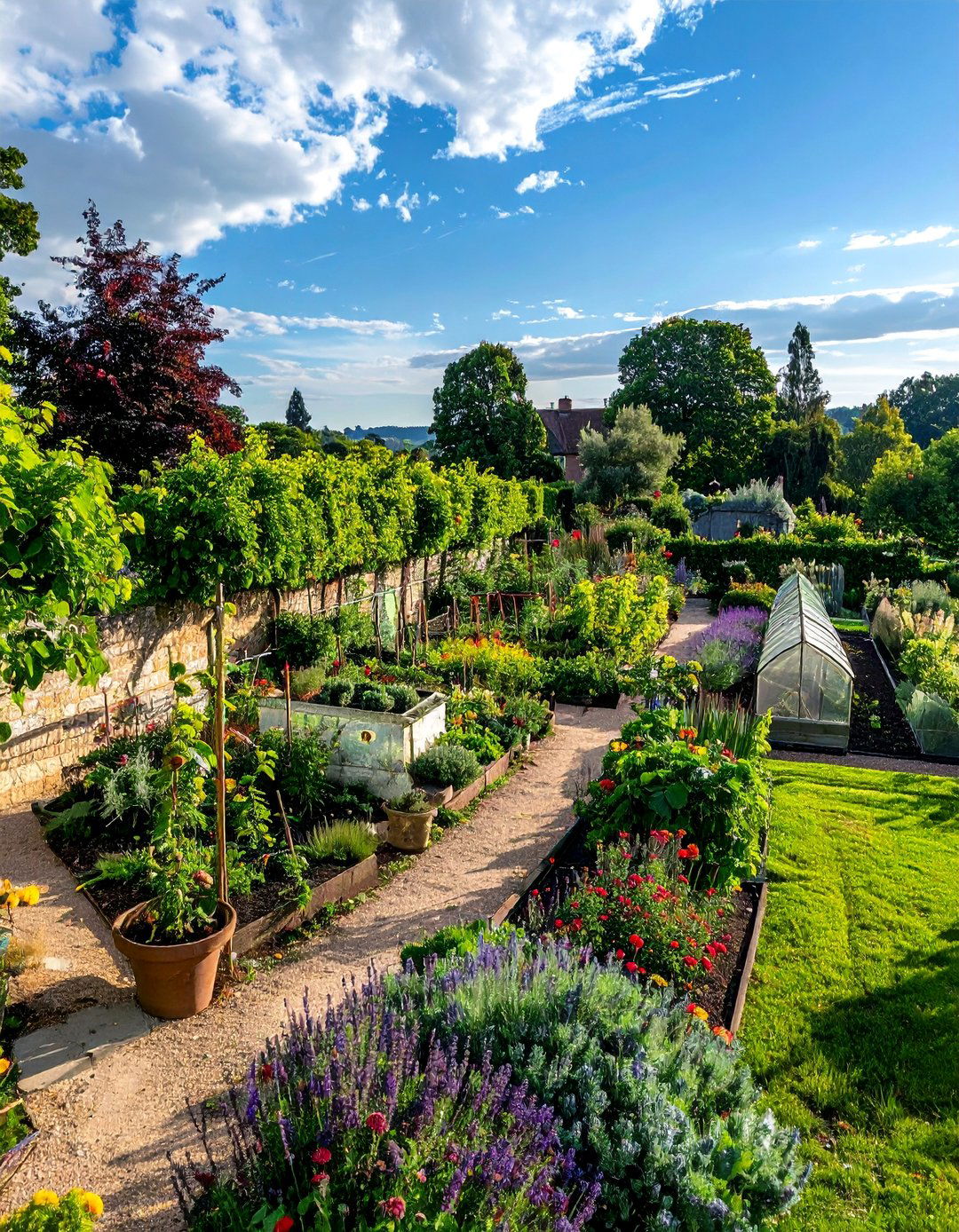
Create an enclosed productive garden within walls or high hedges that combines maximum growing potential with aesthetic appeal through careful design and plant selection. Divide the space into productive sections using permanent pathways that provide structure and access while maintaining the garden's beauty throughout the seasons. Include espaliered fruit trees against the walls to maximize space while providing vertical interest and seasonal beauty from blossom to fruit. Design cold frames and growing structures that enhance rather than detract from the overall appearance while extending the growing season. Include cutting flowers and herbs among the vegetables to provide bouquets for the house while supporting beneficial insects. The enclosed space creates a favorable microclimate that extends the growing season while providing protection from strong winds. This garden type requires significant initial investment but provides enormous satisfaction through its productivity and beauty. Include seating areas where the gardener can rest and enjoy the fruits of their labor.
17. Perennial Color Border
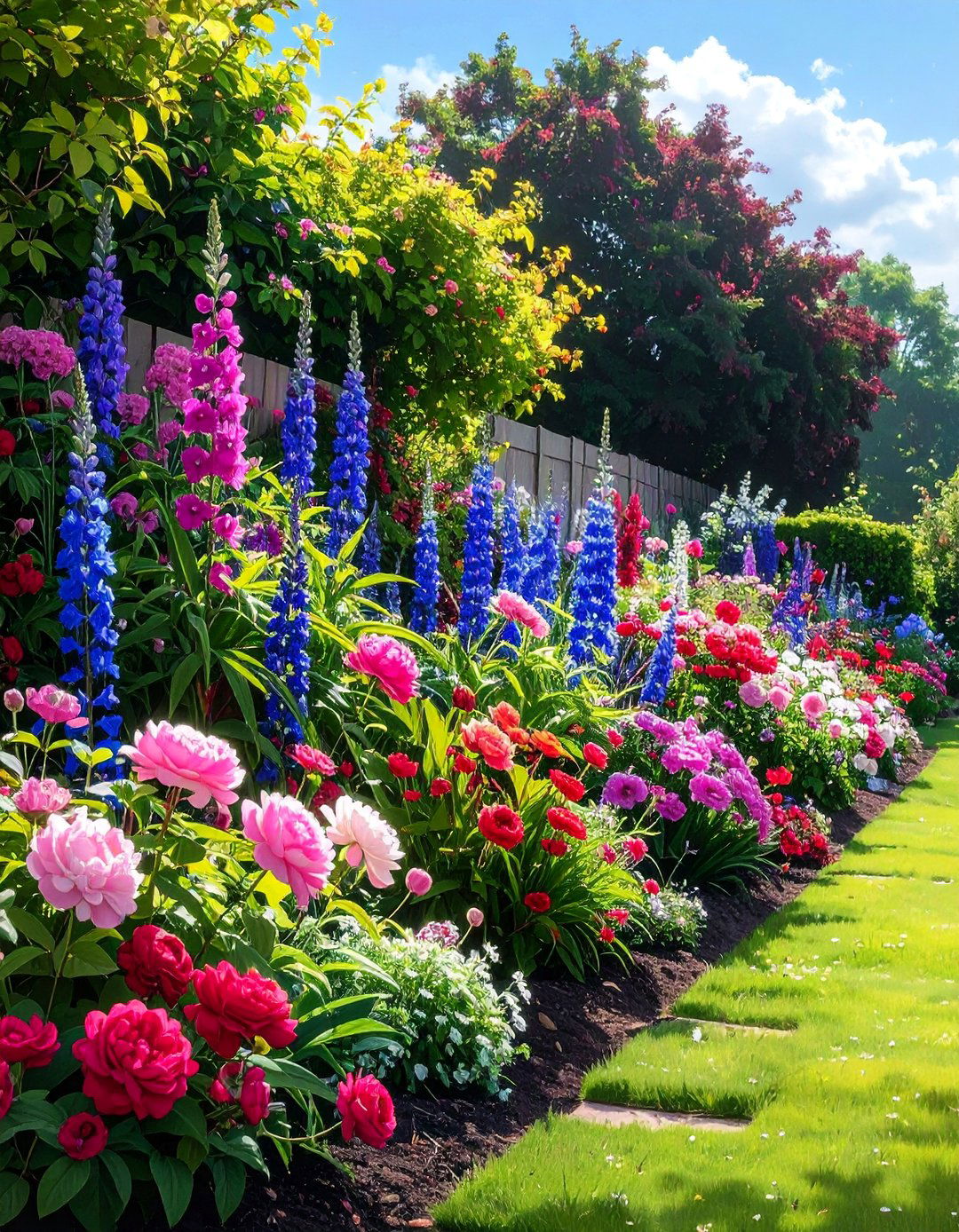
Design a herbaceous border that provides continuous color and interest throughout the growing season using carefully chosen perennial plants arranged by height, color, and blooming period. Plan the border to include early, mid, and late-season bloomers so that something is always in flower while maintaining pleasing color combinations throughout the year. Include plants with attractive foliage to provide interest even when not in bloom, using variations in texture, size, and color to create visual impact. Group plants in odd-numbered drifts that flow into one another rather than creating rigid blocks of single species. Include some taller perennials that add vertical accent without creating a stiff backdrop effect. Plan for autumn interest through plants that provide attractive seed heads, fall foliage color, or late-season blooms. This border type requires annual maintenance including division, staking, and seasonal cleanup but provides enormous reward through its ever-changing display of natural beauty.
18. Mediterranean Gravel Garden
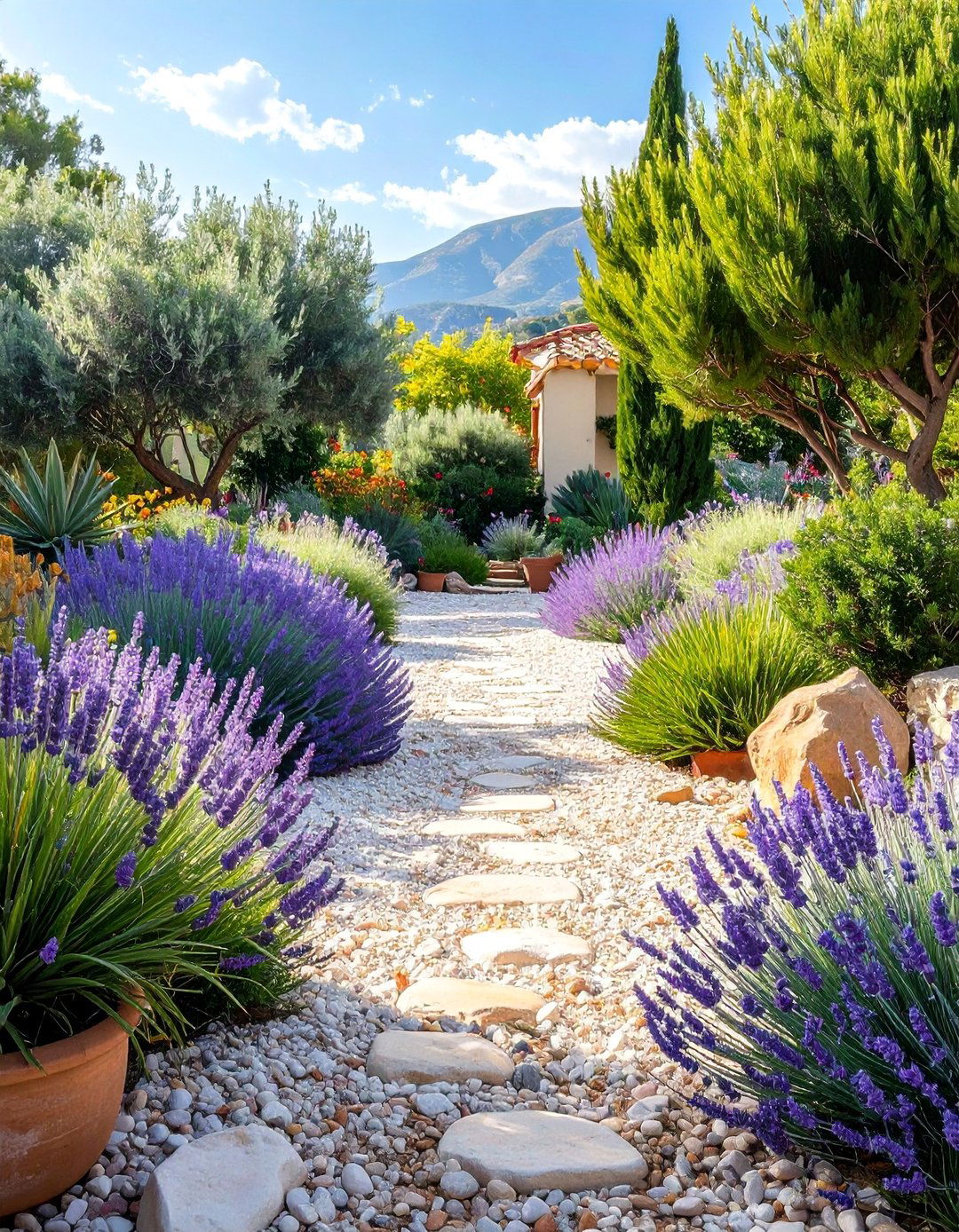
Create a drought-tolerant garden using gravel as both growing medium and decorative element while featuring plants that thrive in well-draining conditions reminiscent of Mediterranean landscapes. Select plants with silver or gray foliage that complement the gravel surface while providing interesting textures and forms throughout the season. Include aromatic herbs like lavender, rosemary, and thyme that release fragrance when warmed by the sun while providing culinary and medicinal benefits. Design the planting to look natural and unstudied while ensuring adequate spacing for mature plant sizes and good visual balance. Include some drought-tolerant perennials that provide seasonal color without requiring additional irrigation once established. This garden type requires minimal maintenance once established while providing year-round interest through attractive foliage and plant forms. The gravel surface suppresses weeds while allowing excellent drainage that many plants prefer, making this an environmentally sustainable approach to gardening.
19. Scented Garden Sanctuary
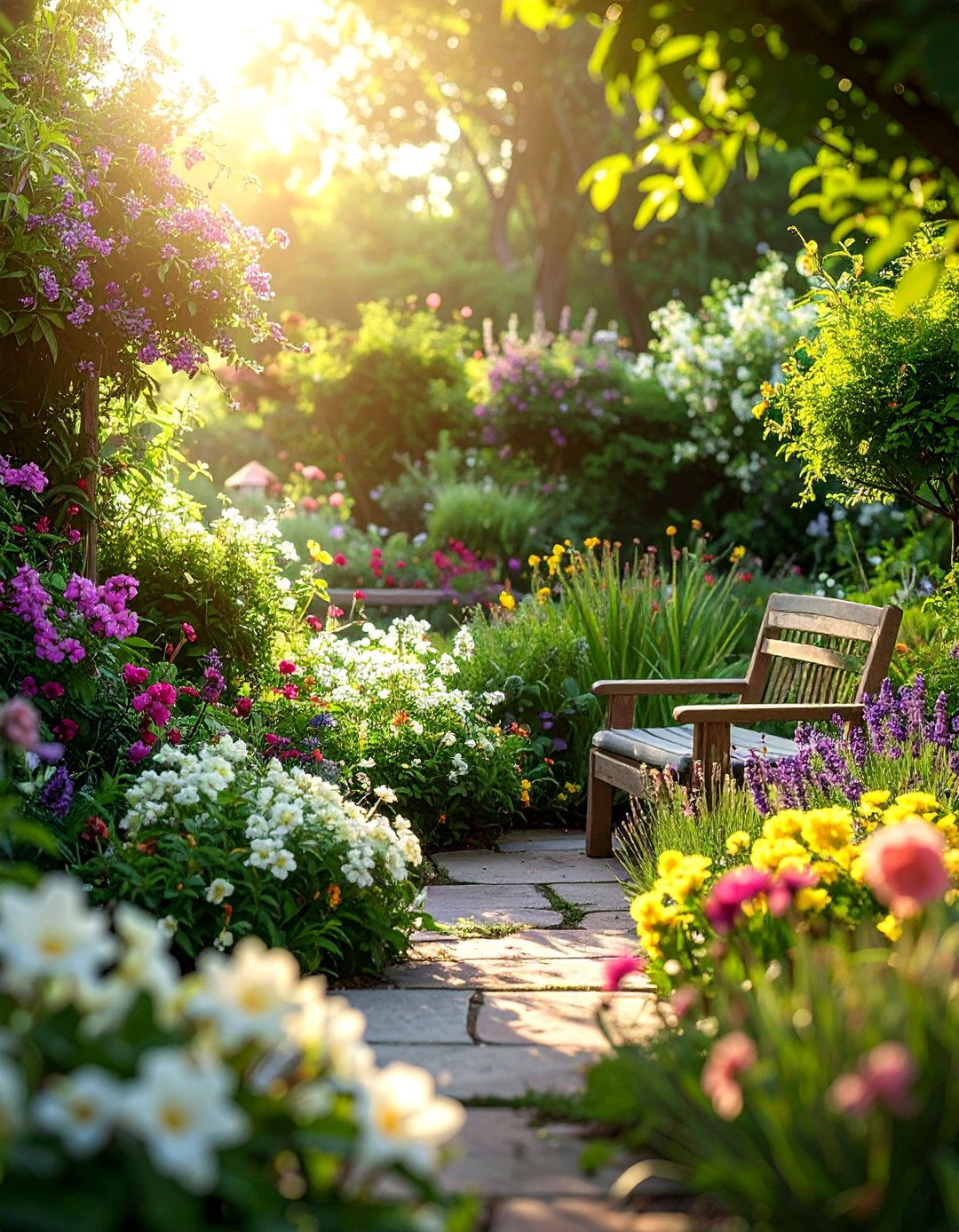
Design a specialized garden area that prioritizes fragrant plants positioned where their scents can be easily enjoyed, creating an immersive sensory experience throughout the seasons. Include plants that release fragrance at different times of day, from morning-scented stocks to evening-fragrant nicotiana and night-blooming jasmine. Position seating areas strategically where prevailing breezes will carry scents to visitors while providing comfortable spots for relaxation and contemplation. Include both foliage plants with aromatic leaves that release scent when touched and flowering plants with perfumed blooms that fill the air with fragrance. Design pathways that encourage visitors to brush against fragrant plants while providing access for maintenance and close appreciation of individual specimens. Include raised planters or containers that bring smaller scented plants closer to nose level for enhanced appreciation. This garden type provides therapeutic benefits while creating memorable experiences for visitors. Plan for succession of scents throughout the growing season to maintain interest and variety.
20. Naturalistic Pond Edge
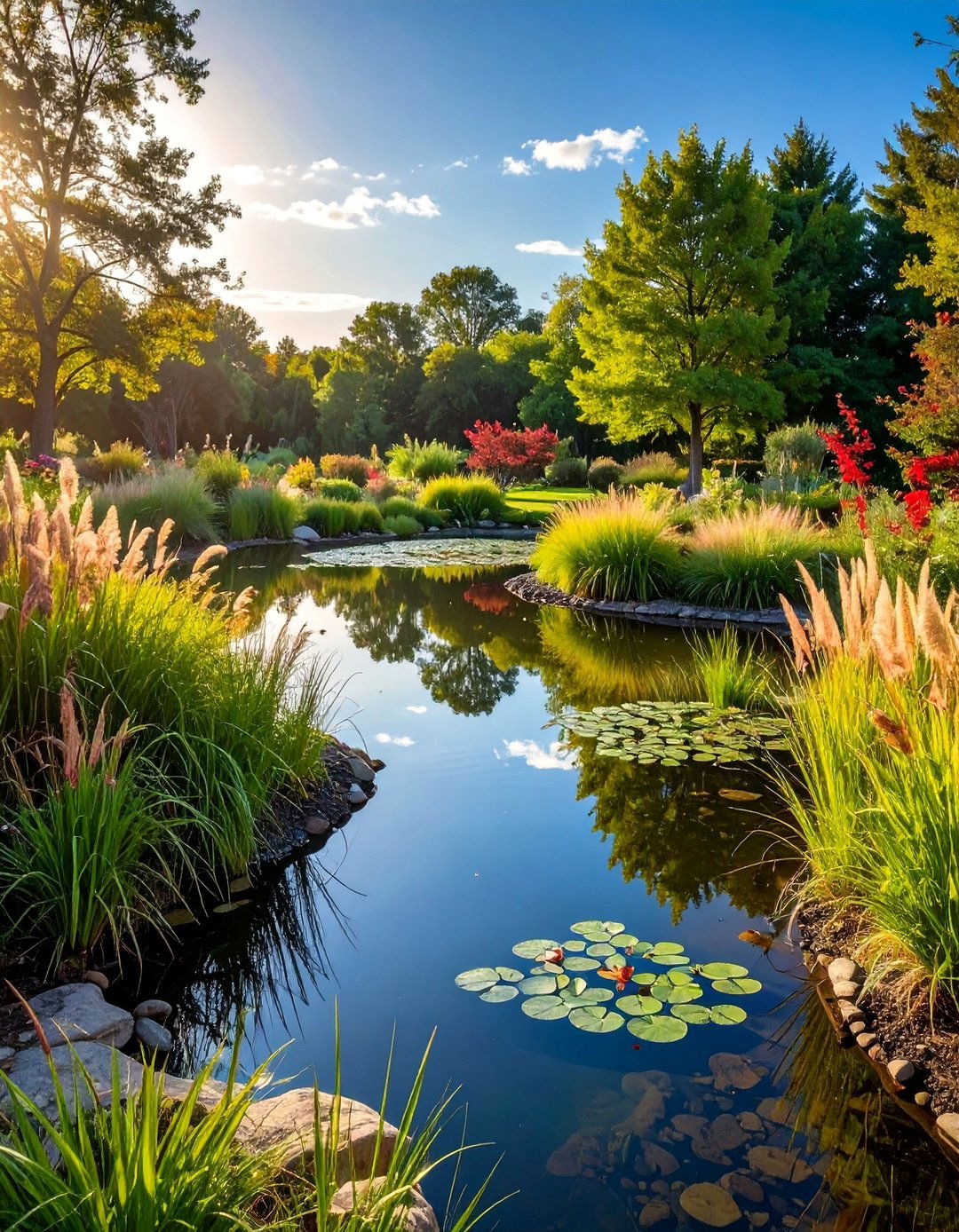
Create a natural-looking water feature surrounded by appropriate plantings that blur the boundaries between water and land while providing habitat for wildlife and visual interest throughout the seasons. Design irregular edges that mimic natural pond formations while including shallow areas for wildlife access and deeper zones for aquatic plants and fish. Plant moisture-gradients that transition from true aquatic plants through marginal species to moisture-loving perennials and finally to ordinary garden plants. Include native plants wherever possible to support local wildlife while creating authentic-looking plant communities. Design pathways and viewing areas that allow appreciation of the water feature without disturbing wildlife while providing access for maintenance. Include structural plants like ornamental grasses and large perennials that provide winter interest when herbaceous plants die back. This type of water feature requires careful initial construction but becomes relatively self-maintaining once ecological balance is established, providing enormous benefit to garden wildlife.
21. Victorian Bedding Display
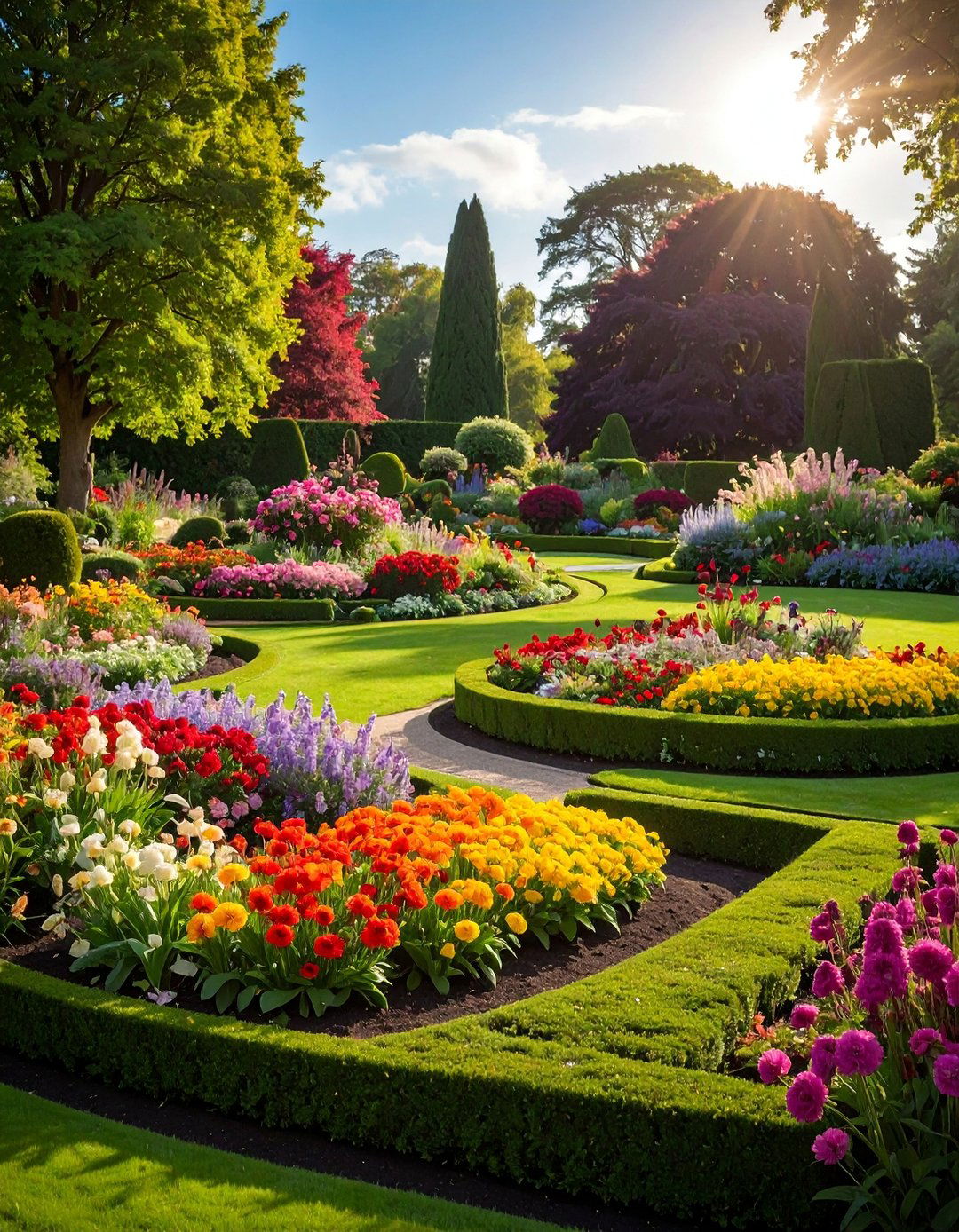
Create colorful seasonal displays using annual plants arranged in patterns or color schemes that reflect the Victorian love of formal bedding while adapting the concept for modern gardens. Design geometric beds that can be planted with different color schemes each season, providing maximum impact and flexibility for changing tastes or garden themes. Include height variation through the use of tall annuals or tender perennials that create dramatic focal points within the broader display. Plan for succession planting that maintains color throughout the growing season while allowing for seasonal transitions between spring, summer, and autumn displays. Include some permanent structural elements like small shrubs or topiary specimens that provide continuity between seasonal changes. This approach requires significant seasonal effort but provides maximum color impact and allows for creative expression through plant combinations and color schemes. Design maintenance access that allows for efficient planting and care while preserving the formal appearance of the displays.
22. Climbing Plant Pavilion
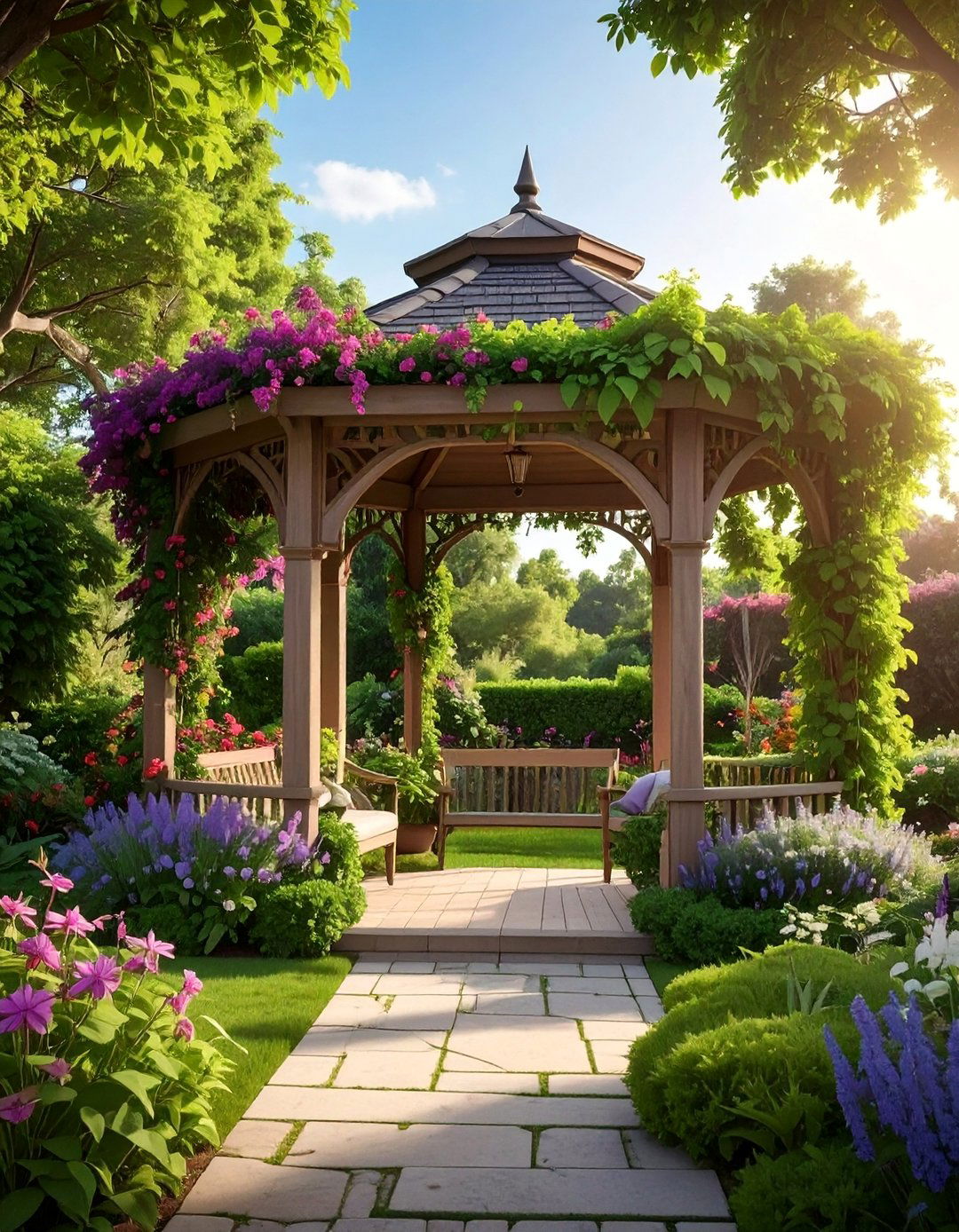
Design a substantial structure such as a gazebo or pavilion that supports vigorous climbing plants, creating an outdoor room that provides shelter while showcasing vertical gardening possibilities. Choose climbers that provide seasonal interest through flowers, foliage, or fruit while ensuring good coverage of the structure without overwhelming its architectural features. Include both deciduous and evergreen climbers to provide year-round interest while allowing for seasonal variation in coverage and appearance. Plan for adequate structural support that can handle the mature weight of climbing plants while ensuring good air circulation to prevent disease problems. Include comfortable seating within the structure where visitors can enjoy intimate views of the climbing plants while being sheltered from weather. Design the surrounding plantings to complement rather than compete with the pavilion while providing additional seasonal interest. This feature requires significant initial investment but creates a dramatic focal point that provides years of enjoyment while demonstrating the garden's vertical potential.
23. Cottage Garden Orchard
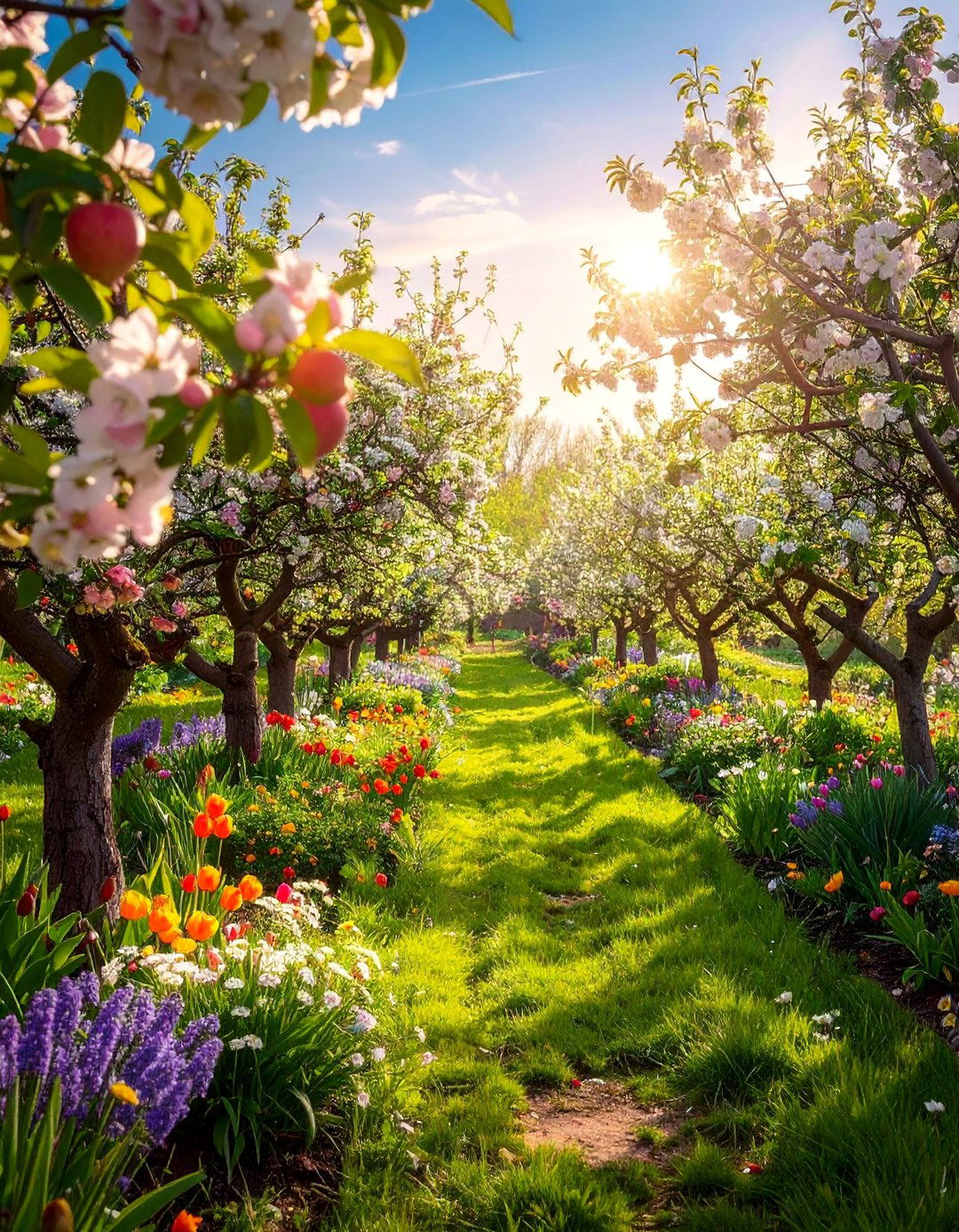
Create a productive orchard that combines fruit trees with cottage garden plantings underneath, maximizing space while providing food, beauty, and wildlife habitat within a single garden area. Choose fruit tree varieties that are appropriate for your climate and space while considering their ornamental value through blossom, fruit, and autumn color. Plant the understory with bulbs, perennials, and herbs that can tolerate the competition from tree roots while providing additional beauty and productivity. Include pathways that provide access for fruit harvest and tree maintenance while creating opportunities for garden appreciation and wildlife observation. Design the spacing to allow adequate light for understory plants while ensuring good air circulation around the trees to prevent disease problems. Include seating areas where visitors can enjoy the orchard during blossom time and throughout the growing season. This approach requires good initial planning but provides enormous satisfaction through its combination of beauty and productivity while supporting beneficial insects and other wildlife.
24. Japanese-Inspired Zen Garden
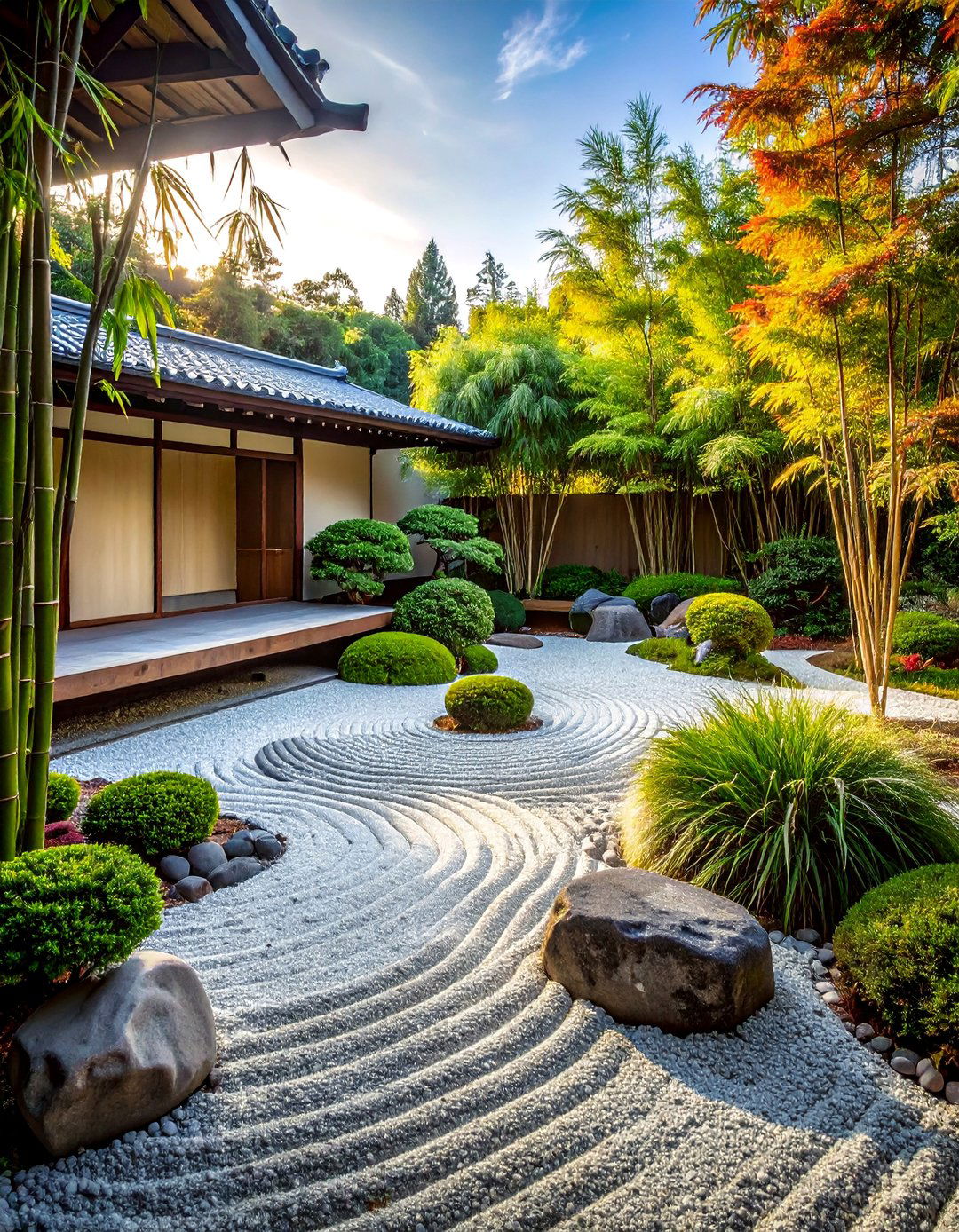
Incorporate elements of Japanese garden design within an English garden context, creating serene spaces that emphasize simplicity, natural materials, and thoughtful plant placement for contemplation and relaxation. Use natural stone, gravel, and water features to create focal points while maintaining the restrained plant palette that characterizes Japanese design principles. Include carefully placed specimen plants that provide year-round interest through attractive form, foliage, or seasonal changes without creating busy or cluttered effects. Design pathways and viewing areas that encourage slow movement and contemplation while providing different perspectives on key garden features. Include elements like bamboo, ornamental grasses, and architectural plants that create interesting shadows and seasonal changes. This approach requires careful planning and restraint but creates garden spaces with timeless appeal and calming atmosphere. Maintenance should focus on preserving the essential character of each element rather than encouraging vigorous growth or dramatic seasonal changes.
25. Cutting Garden Abundance
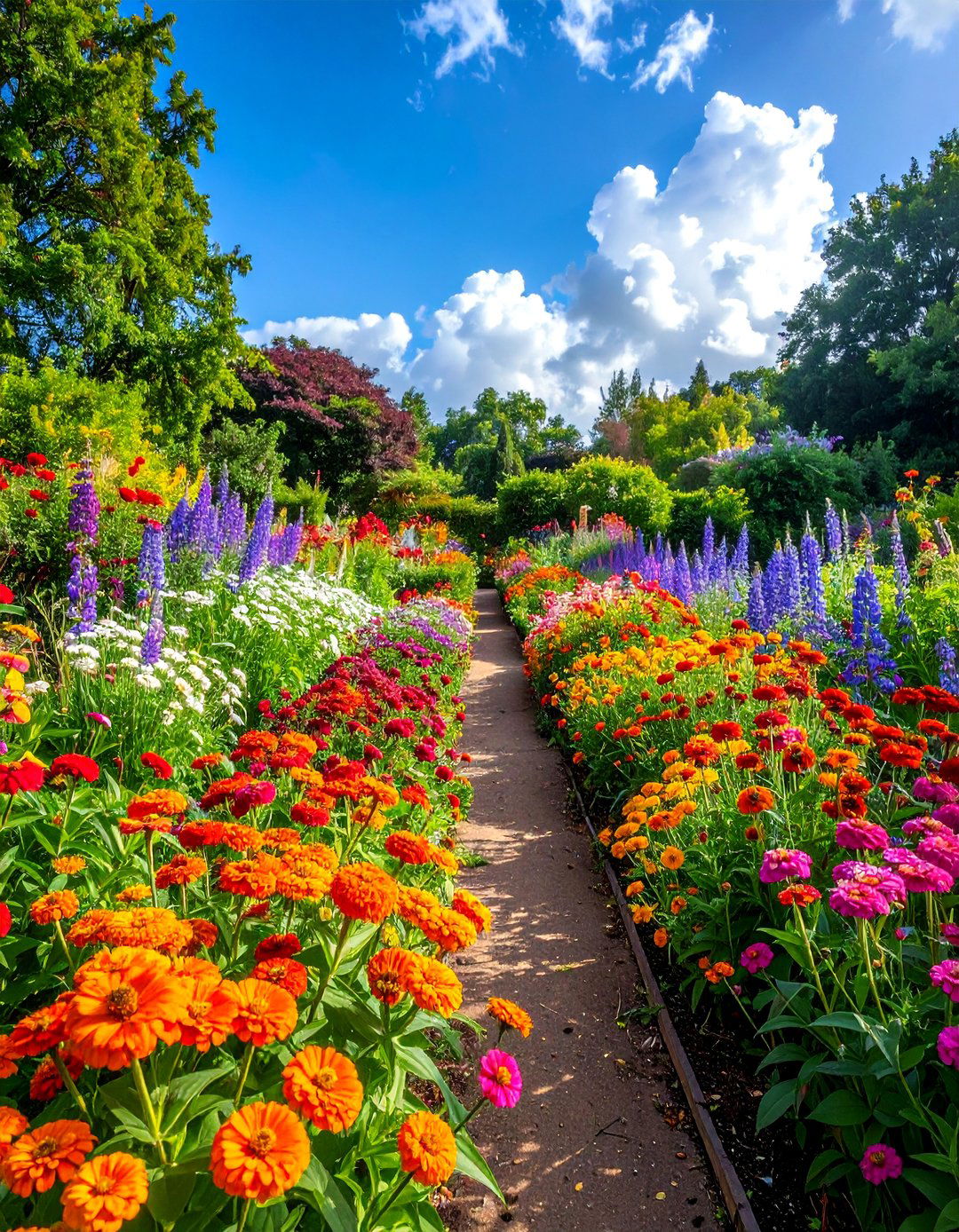
Design a dedicated growing area specifically for producing flowers for indoor arrangements while maintaining ornamental value within the overall garden design through careful plant selection and layout. Include both annual and perennial flowers that provide good cutting material throughout the season while planning for succession planting that ensures continuous availability of fresh material. Arrange plants in rows or blocks that facilitate easy cutting and maintenance while creating attractive displays that can be enjoyed in the garden as well as indoors. Include foliage plants and filler flowers that enhance arrangements while providing structural elements for the garden design. Plan for adequate pathways that allow comfortable access for cutting without damaging surrounding plants while providing space for maintenance activities. Include storage areas for tools and containers that are conveniently located but do not detract from the garden's appearance. This garden type requires regular attention but provides enormous satisfaction through its productivity while beautifying both indoor and outdoor spaces.
26. Formal Rose Parterre
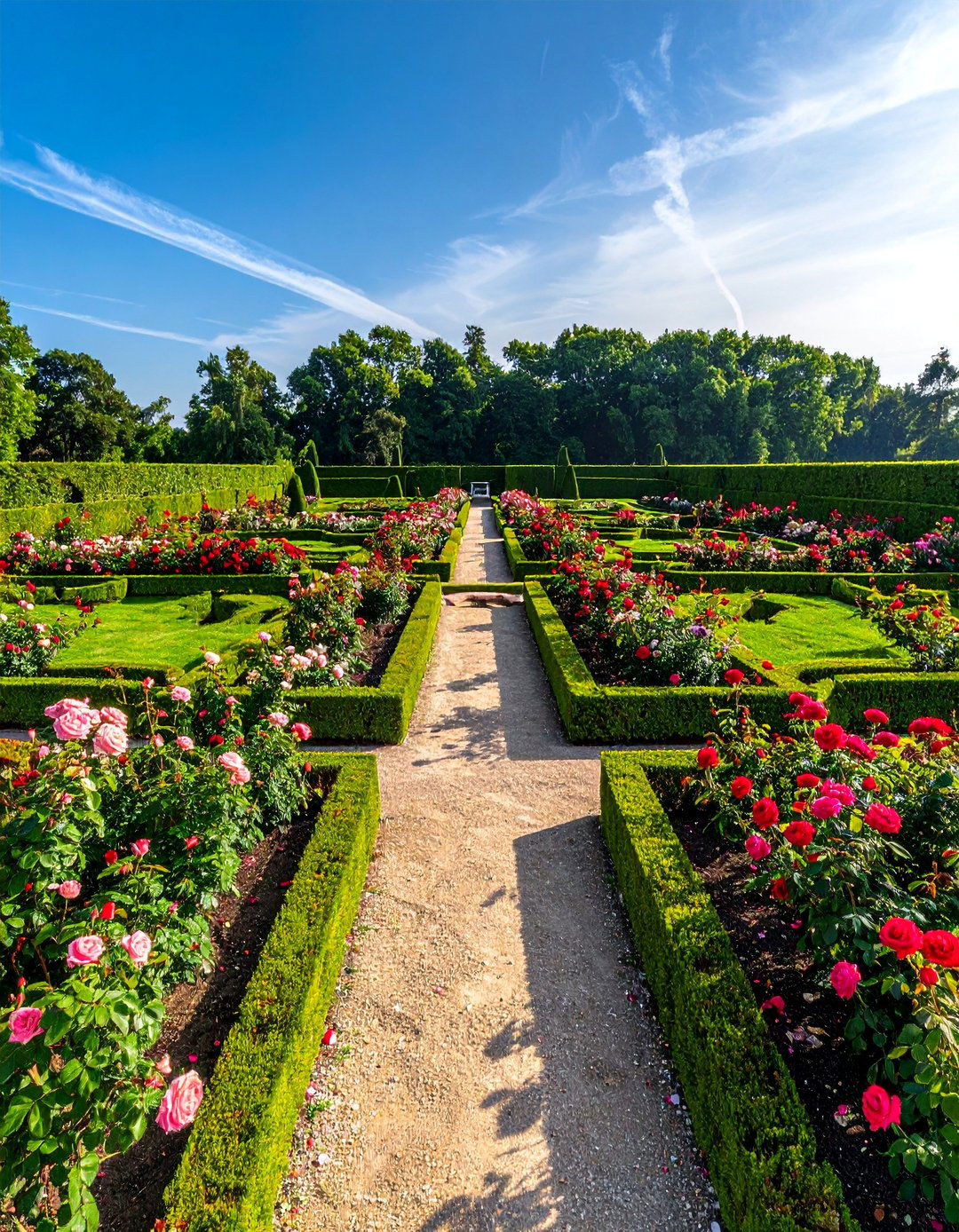
Create an elegant formal garden using roses as the primary planting within a structured framework of hedging and pathways that reflects classical English garden design principles. Choose rose varieties that maintain uniform heights and growth habits while providing excellent flowering performance throughout the season. Design geometric beds separated by pathways that provide access and visual structure while allowing the roses to be appreciated from multiple angles. Include complementary underplanting that enhances rather than competes with the roses while providing interest during non-flowering periods. Incorporate focal points such as sundials, statuary, or water features that anchor the design while providing vertical interest and seasonal focal points. This approach requires regular maintenance to preserve the formal character but creates garden spaces of timeless elegance and sophistication. Plan for seasonal care including pruning, feeding, and disease prevention that maintains both plant health and garden appearance.
27. Wildlife Habitat Border
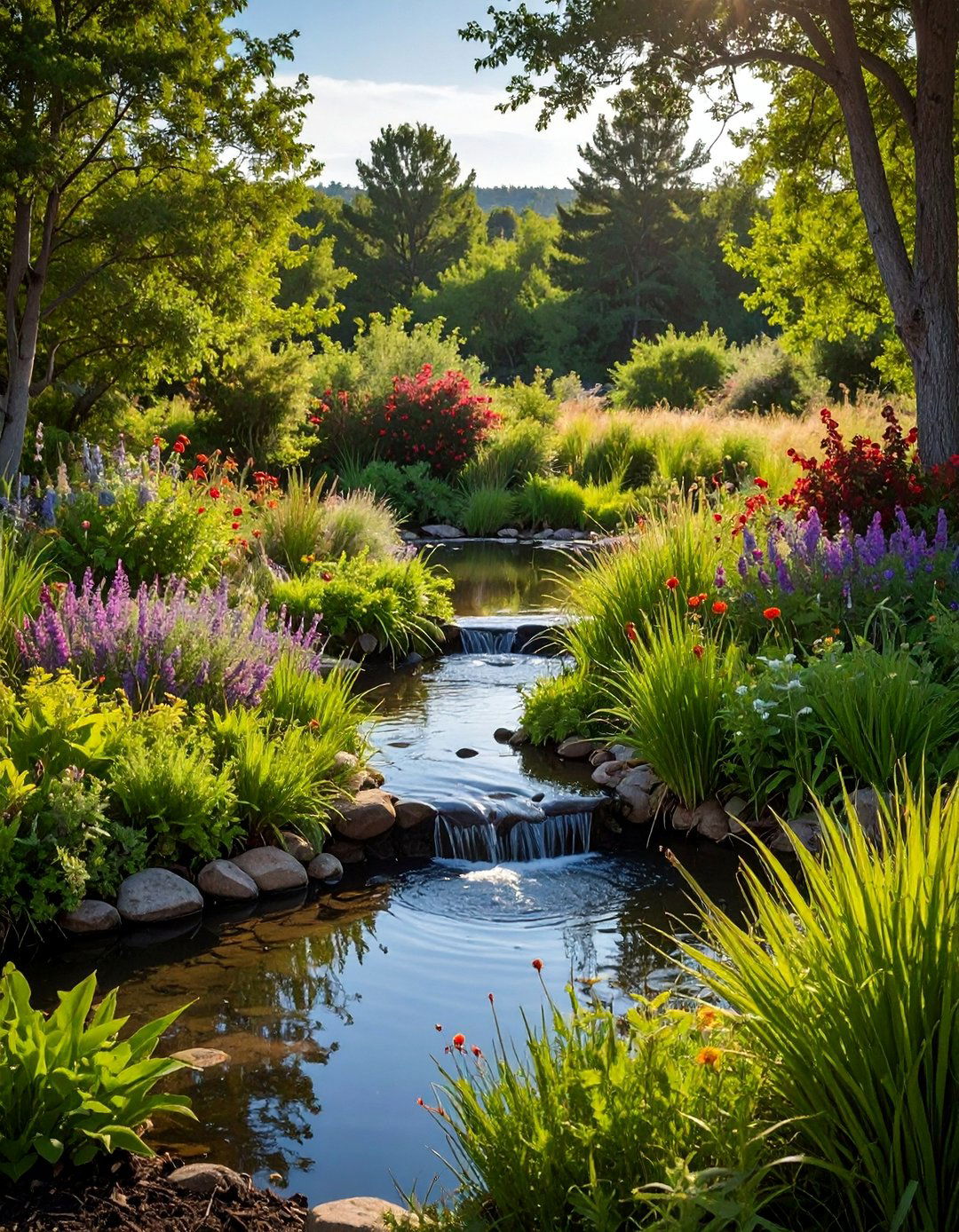
Design plantings specifically to attract and support wildlife while maintaining ornamental value through careful plant selection and garden layout that benefits both animals and human enjoyment. Include native plants wherever possible to provide familiar food sources and nesting opportunities while creating authentic plant communities that require minimal maintenance once established. Plan for different habitat types including shelter, nesting sites, and food sources that support various wildlife species throughout the year. Include water features and varied planting heights that provide different microhabitats while creating visual interest and seasonal beauty. Design pathways and viewing areas that allow wildlife observation without causing disturbance while providing access for garden maintenance. Include plants that provide seeds, berries, and nectar throughout the year while creating attractive displays for human enjoyment. This approach requires thoughtful planning but creates gardens that contribute to environmental health while providing educational opportunities and aesthetic pleasure.
28. Cottage Garden Greenhouse Area
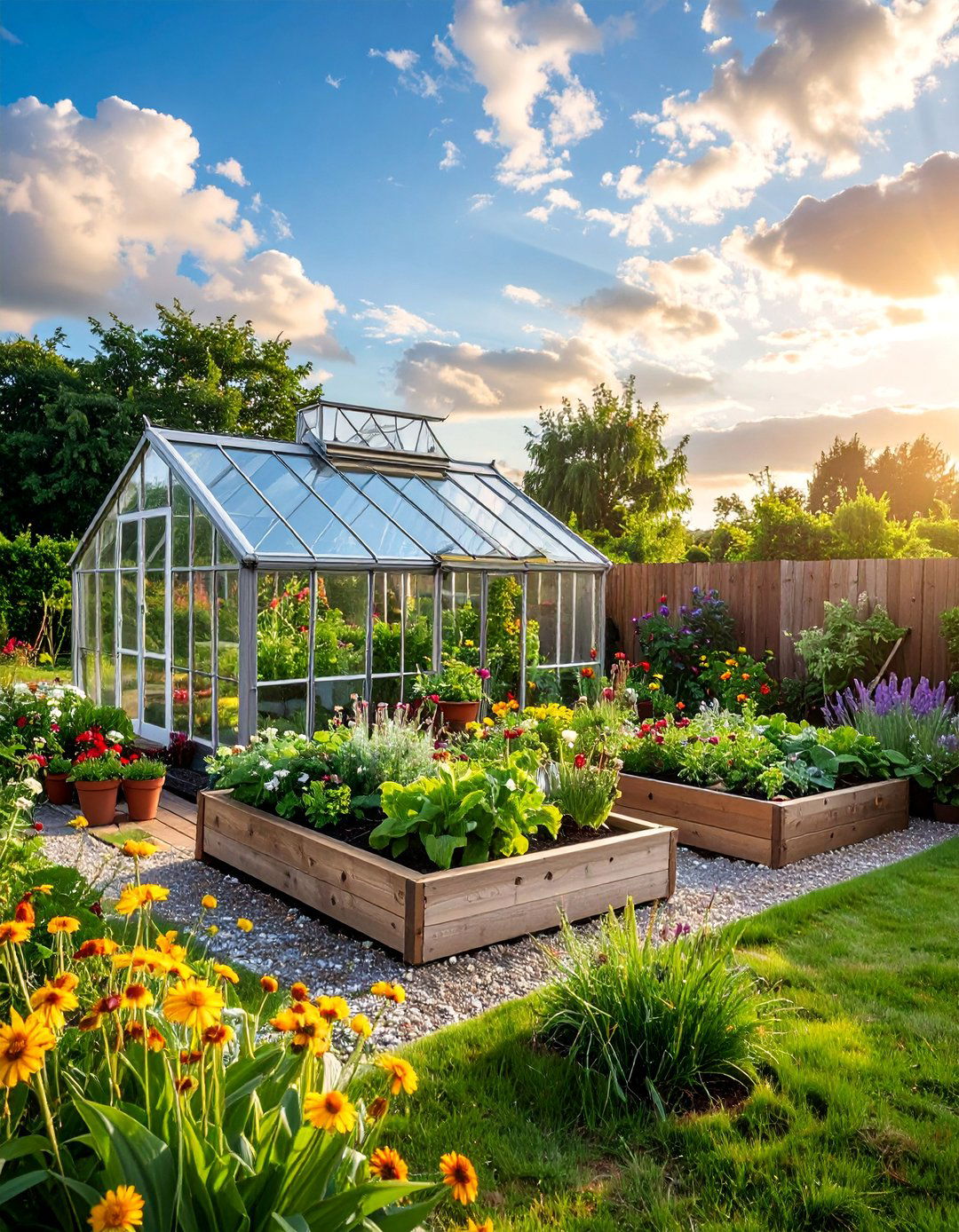
Create a dedicated growing area featuring a greenhouse or cold frame surrounded by complementary plantings that extend the growing season while providing a functional and attractive garden focal point. Position the greenhouse to receive optimal light while integrating it visually with surrounding garden features through appropriate plantings and pathway design. Include raised beds and container growing areas that provide additional growing space while creating attractive displays of vegetables, herbs, and flowers. Design storage areas for tools and materials that are convenient but aesthetically integrated with the overall design. Include climber-covered structures that provide additional growing space while softening the hard lines of utilitarian buildings. Plan for seasonal use patterns that maintain garden beauty throughout the year while maximizing productive potential during peak growing periods. This approach requires significant initial investment but provides enormous value through extended growing seasons and garden productivity while creating attractive focal points within the overall garden design.
29. Herbaceous Meadow Border
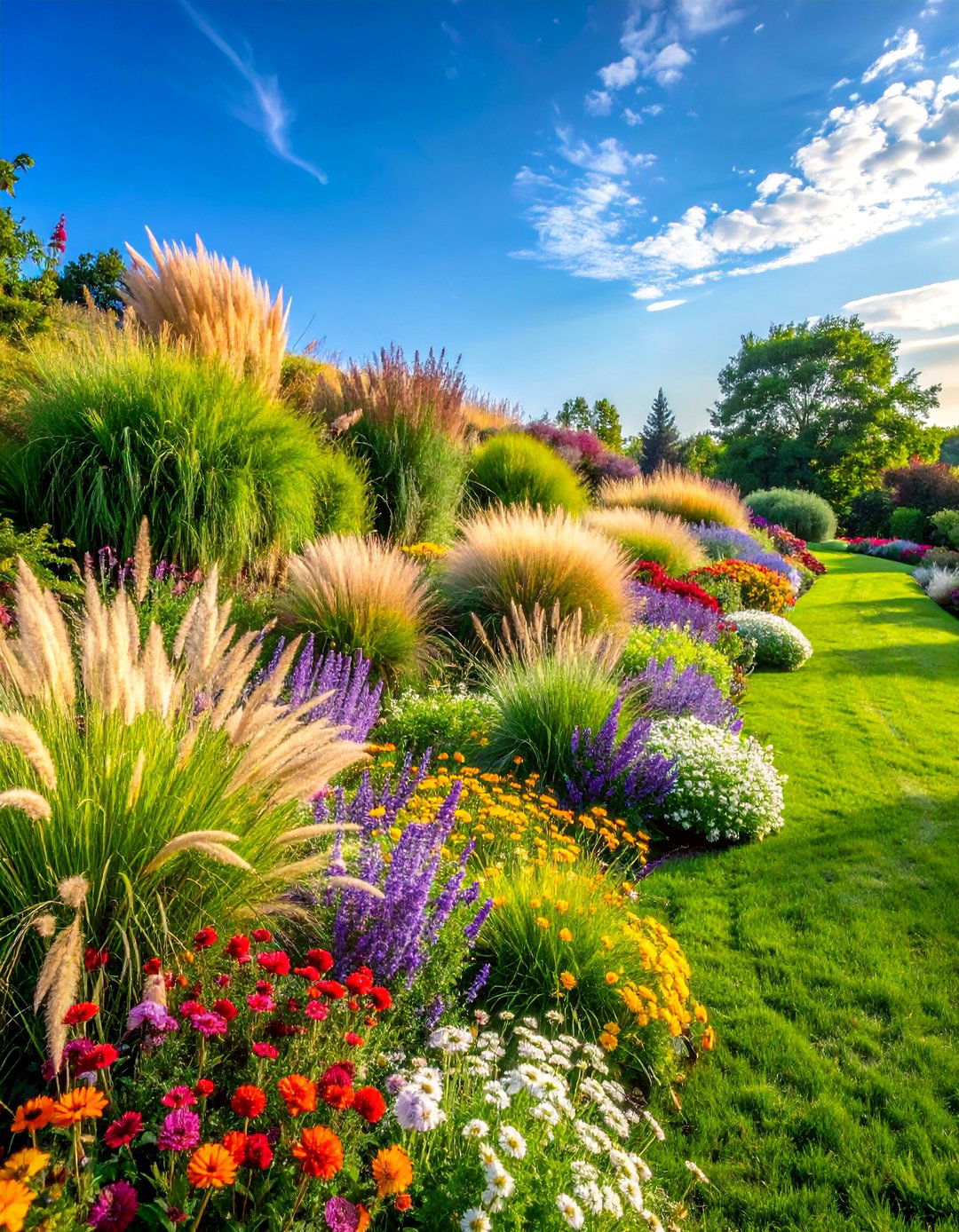
Design a naturalistic border that mimics wildflower meadow conditions while using garden-worthy perennials and grasses that provide more reliable performance than true wildflowers in garden settings. Select plants that create natural-looking communities while providing sequential flowering throughout the growing season. Include ornamental grasses that provide movement and winter interest while supporting the naturalistic character of the planting design. Plan for minimal maintenance once established while ensuring adequate pathways for access and viewing opportunities that allow appreciation of the border's seasonal changes. Include bulbs that naturalize within the border while providing early season color before perennial growth begins. This approach creates gardens that appear effortless while requiring thoughtful plant selection and initial establishment care. The naturalistic appearance provides habitat for wildlife while requiring less intensive maintenance than formal garden borders, making it an environmentally sustainable approach to garden design.
30. Formal Water Garden
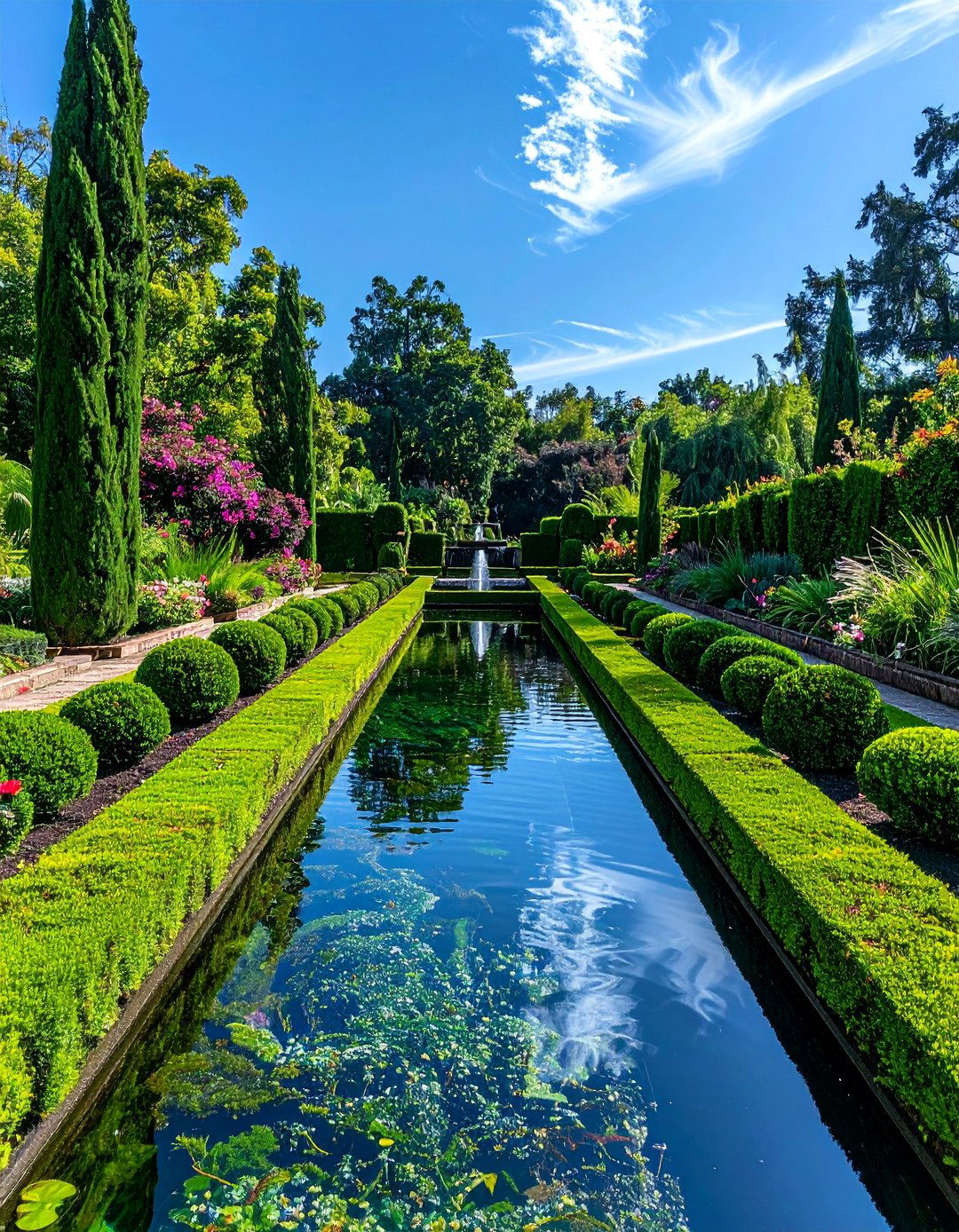
Create an elegant water feature that combines formal design elements with aquatic plantings in a structured layout that provides both visual impact and peaceful atmosphere within the garden. Design geometric pools connected by rills or channels that create visual flow while providing opportunities for different types of aquatic plants and wildlife habitat. Include fountains or other water movement features that provide sound while ensuring adequate oxygenation for fish and plant health. Plan the surrounding hardscaping using materials that complement the overall garden design while providing appropriate edging and pathways for maintenance and viewing. Include formal plantings around the water feature that enhance rather than compete with the water element while providing seasonal interest and structural backdrop. This type of feature requires significant initial investment and ongoing maintenance but creates a dramatic focal point that provides year-round beauty while supporting garden wildlife and creating opportunities for contemplation and relaxation.
31. English Country Churchyard
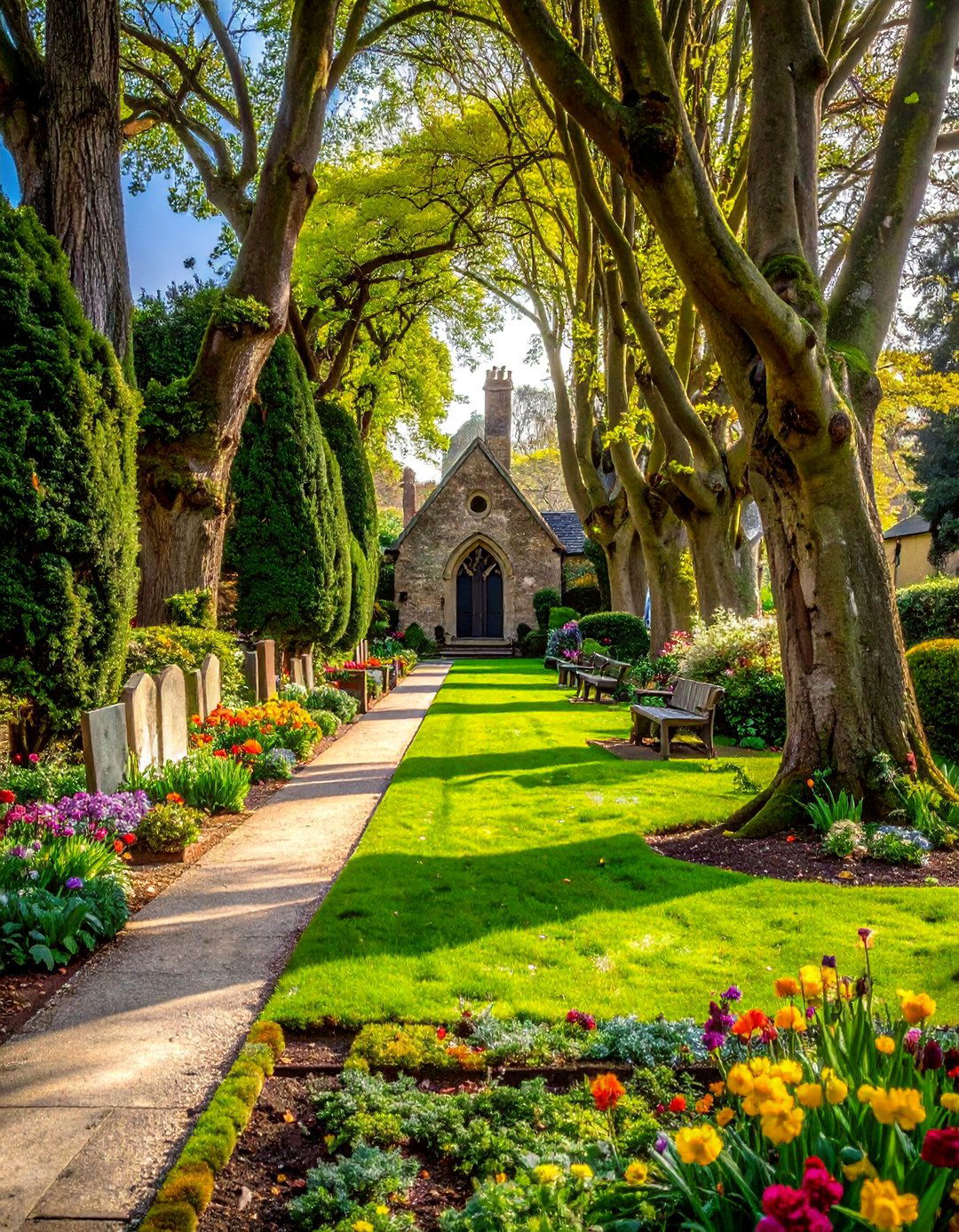
Create a peaceful garden area inspired by traditional English churchyards using plants and design elements that evoke tranquility, remembrance, and natural beauty through thoughtful plant selection and layout. Include traditional plants such as yew, roses, and spring bulbs that provide seasonal interest while maintaining the timeless character associated with churchyard gardens. Design pathways using natural materials that encourage quiet contemplation while providing access to all areas of the garden space. Include seating areas positioned to provide views of the garden while creating intimate spaces for reflection and rest. Plan for minimal maintenance requirements while ensuring the garden retains its peaceful character throughout the seasons. Include memorial elements such as sundials, benches with inscriptions, or other features that provide focal points while contributing to the garden's contemplative atmosphere. This approach creates garden spaces with spiritual dimension while providing habitat for wildlife and opportunities for quiet enjoyment of natural beauty.
32. Espalier Fruit Garden
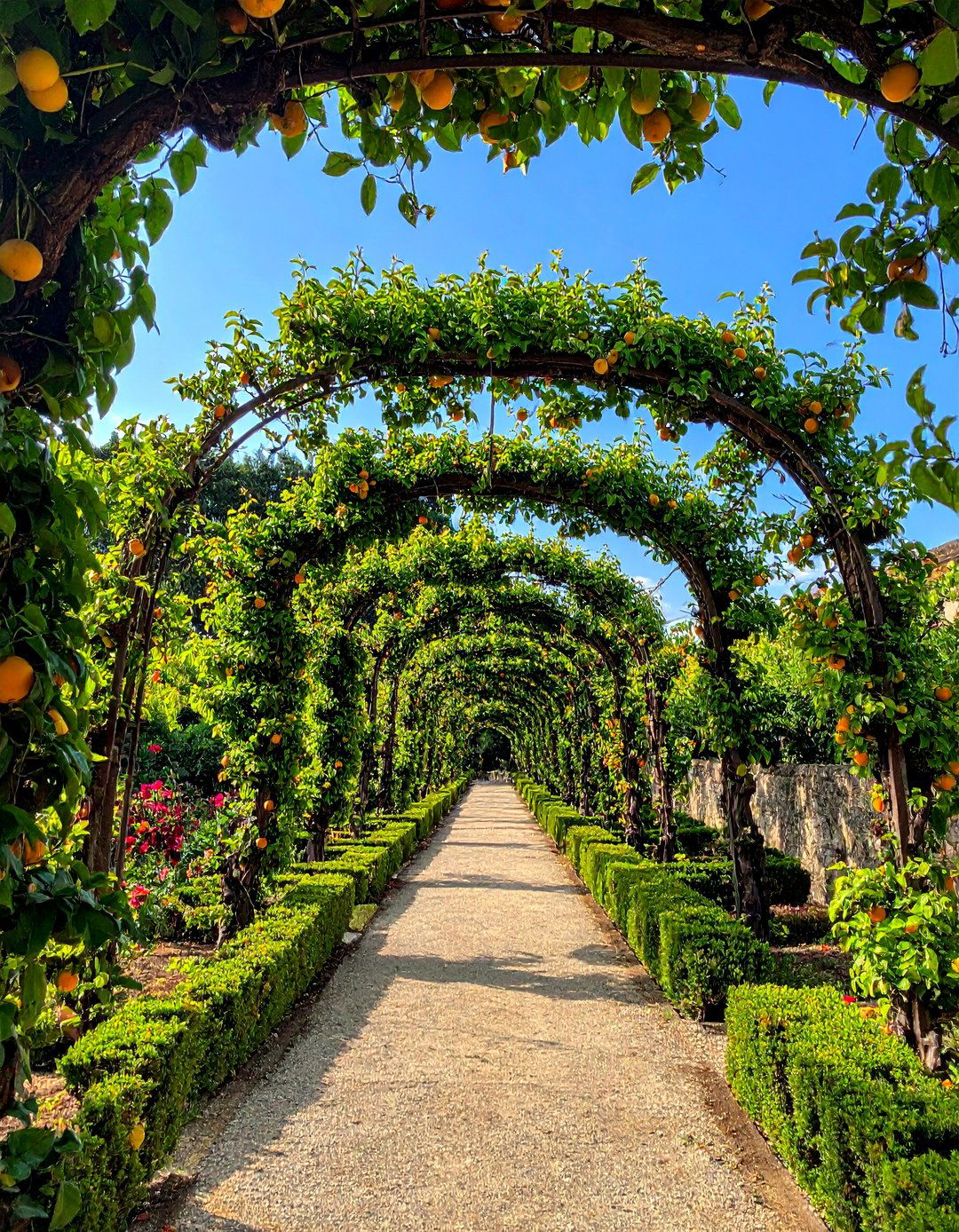
Design a productive garden featuring fruit trees trained against walls, fences, or freestanding supports in decorative patterns that maximize growing space while creating beautiful structural elements within the garden. Choose fruit varieties appropriate for espalier training while considering their ornamental value through blossom, fruit, and seasonal foliage changes. Include adequate support structures that can accommodate mature trees while contributing positively to the garden's overall design aesthetic. Plan for regular training and pruning that maintains both productive capacity and ornamental appearance while ensuring adequate light and air circulation. Include complementary plantings that enhance the espalier displays while providing additional productivity and beauty within the available space. Design pathways and viewing areas that showcase the espalier work while providing access for maintenance and harvest activities. This approach requires specialized knowledge and regular attention but creates gardens that demonstrate horticultural skill while providing food and beauty within limited space.
33. Shade Perennial Sanctuary
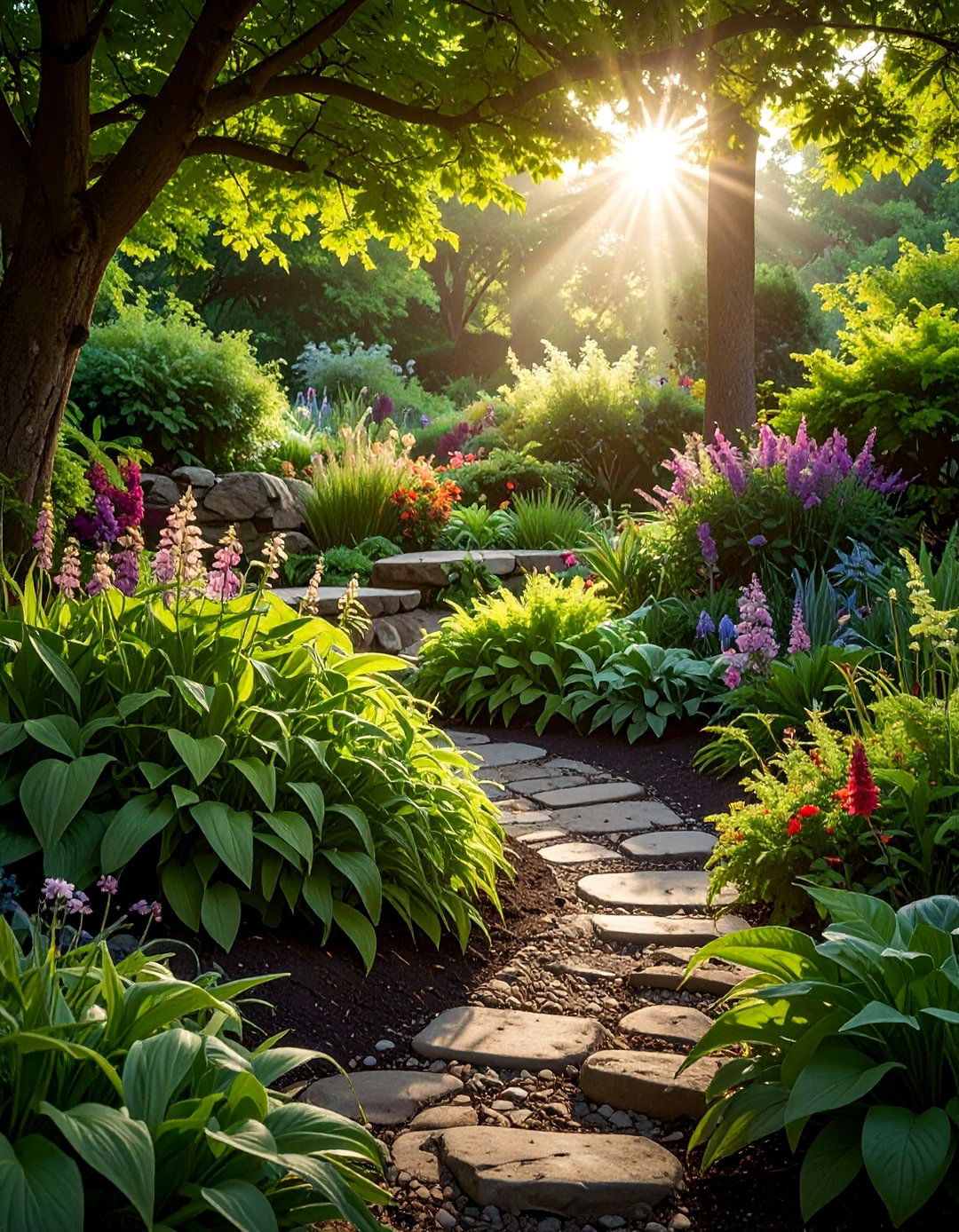
Create a specialized garden area for shade-loving perennials that transforms difficult growing conditions into opportunities for distinctive beauty through careful plant selection and design. Include plants with attractive foliage that provide interest even when not flowering, using variations in leaf size, color, and texture to create compelling combinations. Plan for sequential flowering that provides color throughout the growing season while maintaining the overall design's coherent character. Include structural elements such as large rocks, garden art, or architectural plants that provide focal points and year-round interest. Design pathways that encourage exploration while providing access for maintenance and close appreciation of individual plants. Include early spring bulbs that take advantage of light conditions before deciduous trees leaf out, providing important early season color and interest. This approach creates gardens that thrive in challenging conditions while providing peaceful retreat spaces that require relatively minimal maintenance once established.
34. Victorian Conservatory Garden
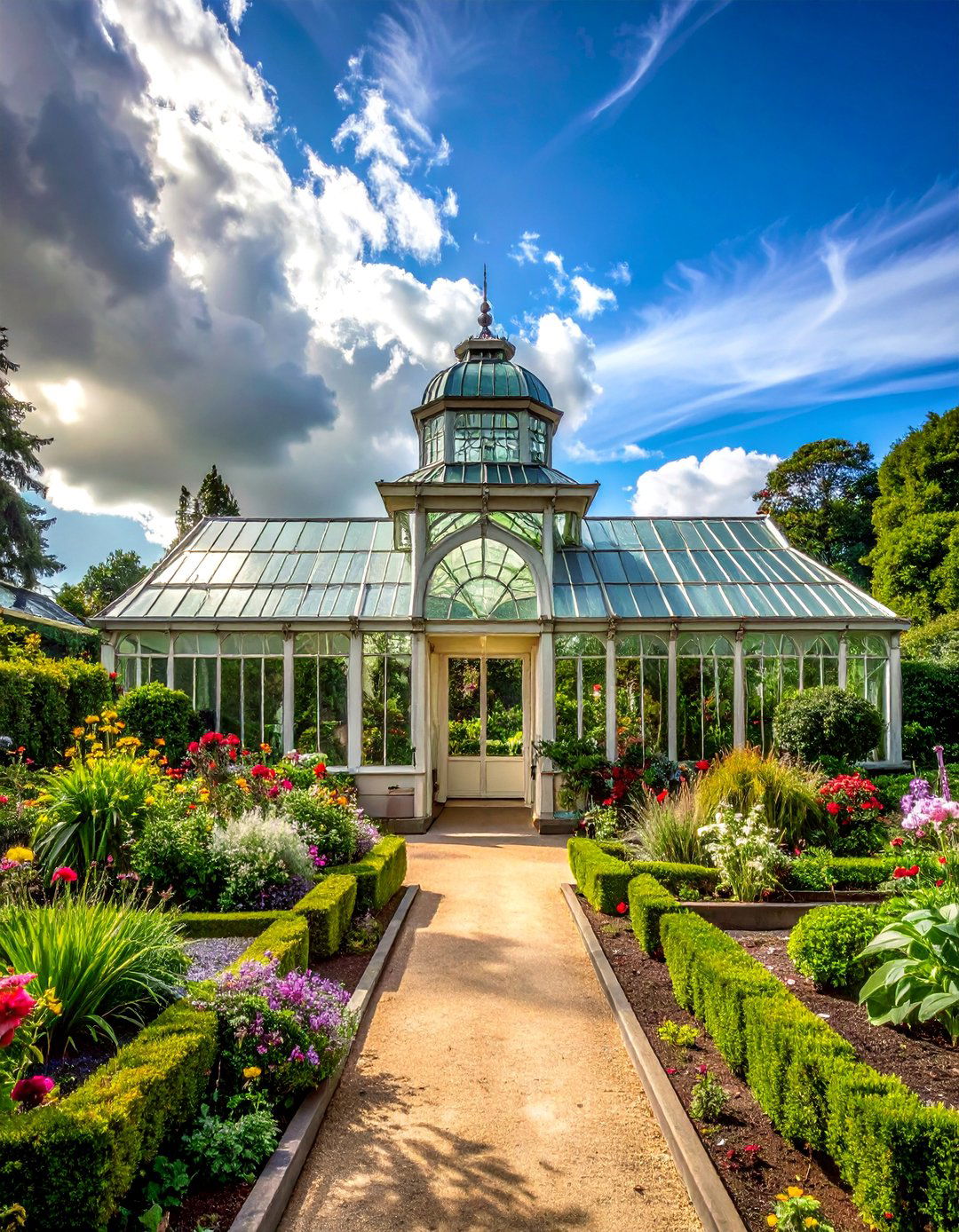
Design plantings that complement and extend a conservatory or greenhouse into the surrounding garden space while creating seamless transitions between indoor and outdoor growing areas. Include tender plants that can be moved between indoor and outdoor locations seasonally while maintaining the garden's overall design integrity. Plan for microclimates that allow borderline hardy plants to thrive outdoors while providing backup growing space for valuable specimens. Include raised beds and container displays that facilitate easy plant movement while creating attractive arrangements throughout the growing season. Design storage and work areas that support the conservatory garden while maintaining aesthetic integration with the overall landscape design. Plan for seasonal displays that take advantage of the conservatory's climate control while providing spectacular outdoor shows during favorable weather. This approach requires significant infrastructure investment but creates opportunities for growing a much wider range of plants while providing year-round gardening activities and indoor beauty during winter months.
35. Dry Stone Wall Garden
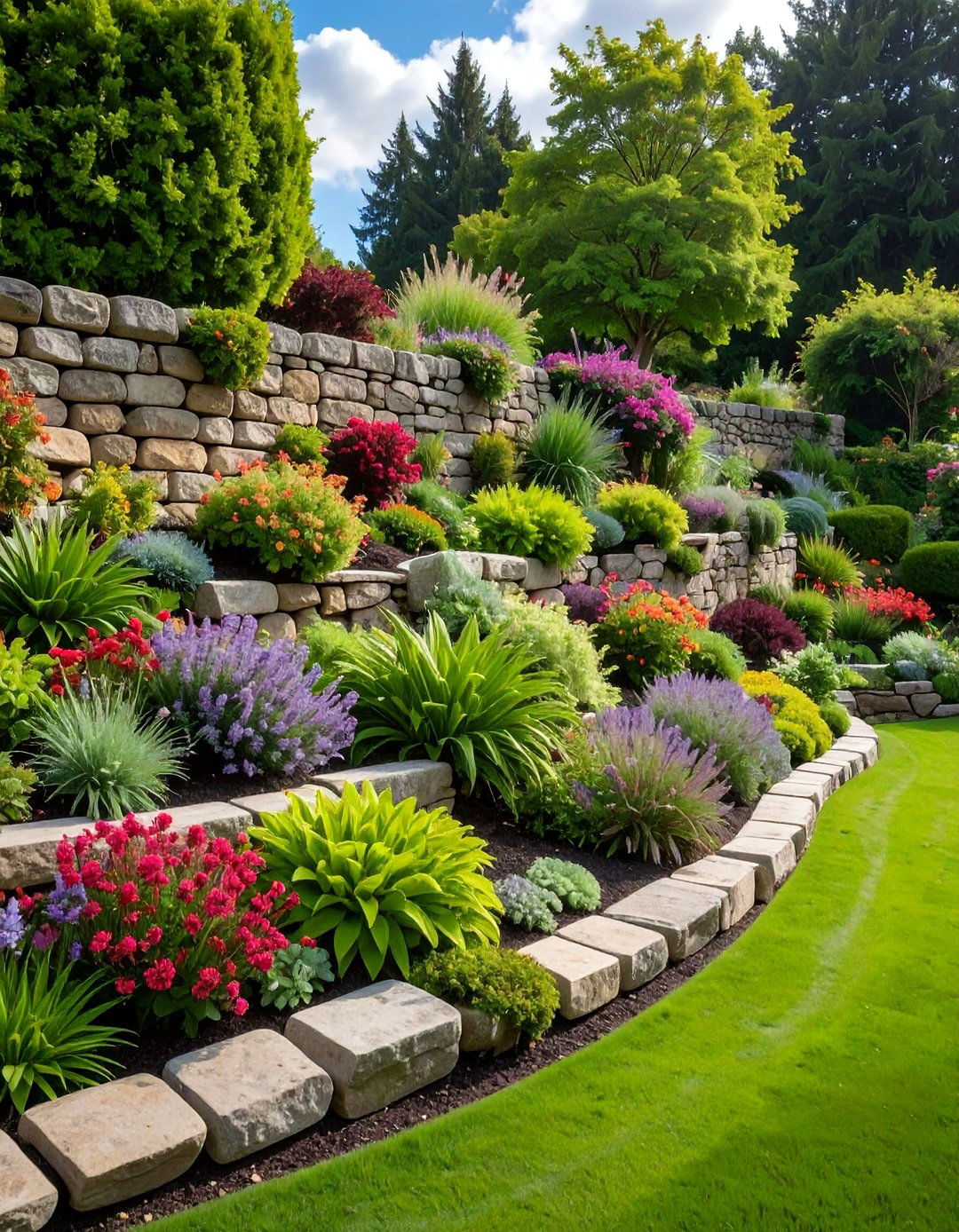
Create attractive and functional retaining walls using traditional dry stone construction techniques while incorporating planting pockets that transform utilitarian structures into beautiful garden features. Include plants that thrive in the well-draining conditions provided by stone walls while providing seasonal interest and wildlife habitat. Design the wall construction to include adequate planting spaces while maintaining structural integrity and visual appeal. Plan for different exposures and microclimates that allow for varied plant communities within the wall structure itself. Include traditional wall plants such as wallflowers, sedums, and ferns that create authentic character while requiring minimal maintenance once established. Design the surrounding plantings to complement and enhance the wall feature while providing additional growing space and seasonal beauty. This approach requires skilled construction techniques but creates permanent garden features that improve with age while providing valuable growing space and attractive focal points within the garden design.
36. Seasonal Succession Garden
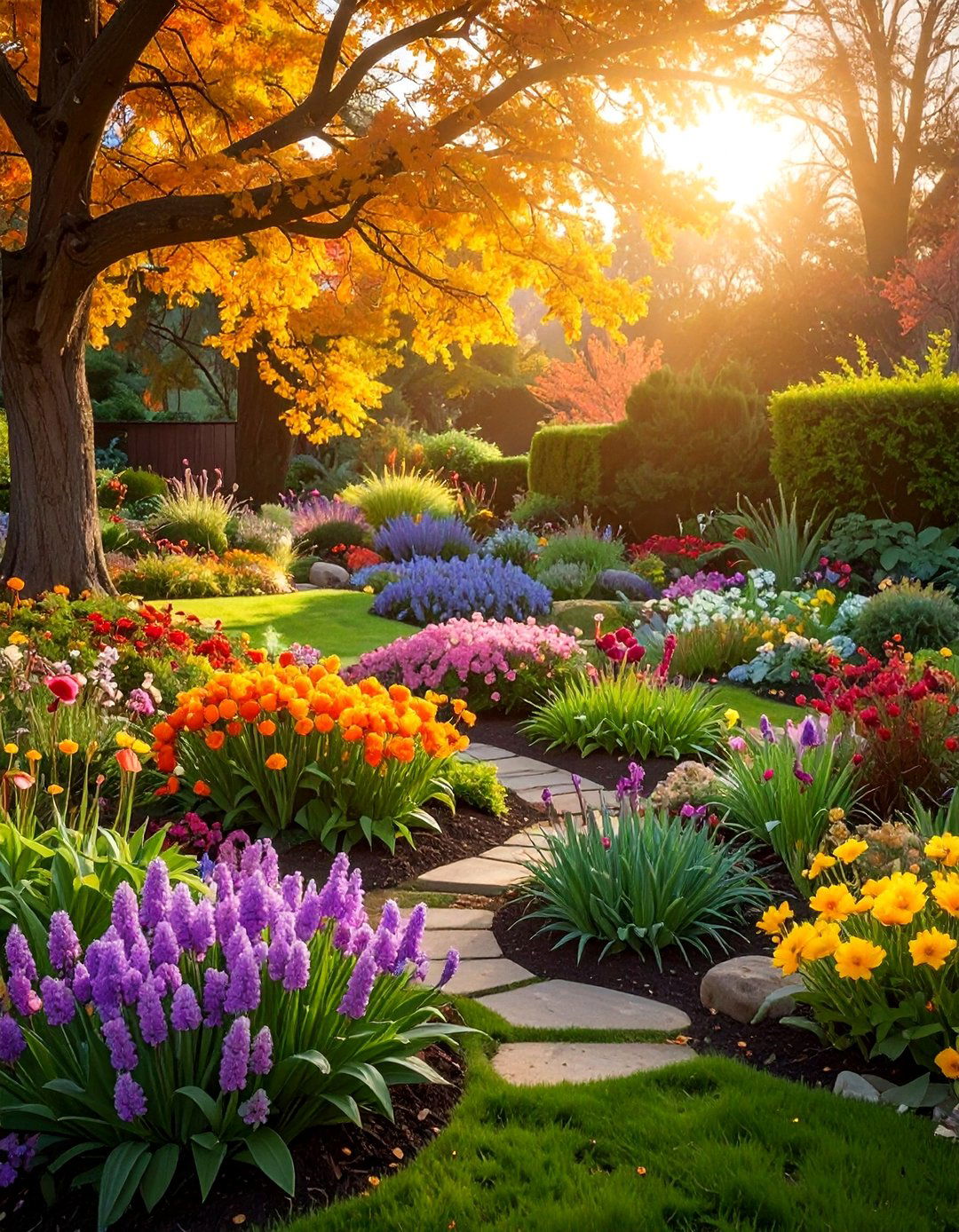
Design garden areas that provide continuous interest through careful planning of plants that flower or provide peak interest at different times throughout the year. Include early spring bulbs, late spring and early summer perennials, midsummer annuals, autumn-flowering plants, and winter structural elements that ensure something attractive is always present. Plan for smooth transitions between seasonal peaks while maintaining overall design coherence throughout the year. Include plants with multiple seasons of interest such as those providing spring flowers, summer foliage, autumn color, and winter structure. Design pathways and viewing areas that showcase seasonal changes while providing access for maintenance and close appreciation of individual specimens. Include storage and work areas that support the intensive management required for succession plantings while maintaining the garden's aesthetic integrity. This approach requires careful planning and seasonal activity but creates gardens that provide maximum interest and beauty throughout the entire year while demonstrating advanced horticultural knowledge and skill.
37. Cottage Garden Potting Shed
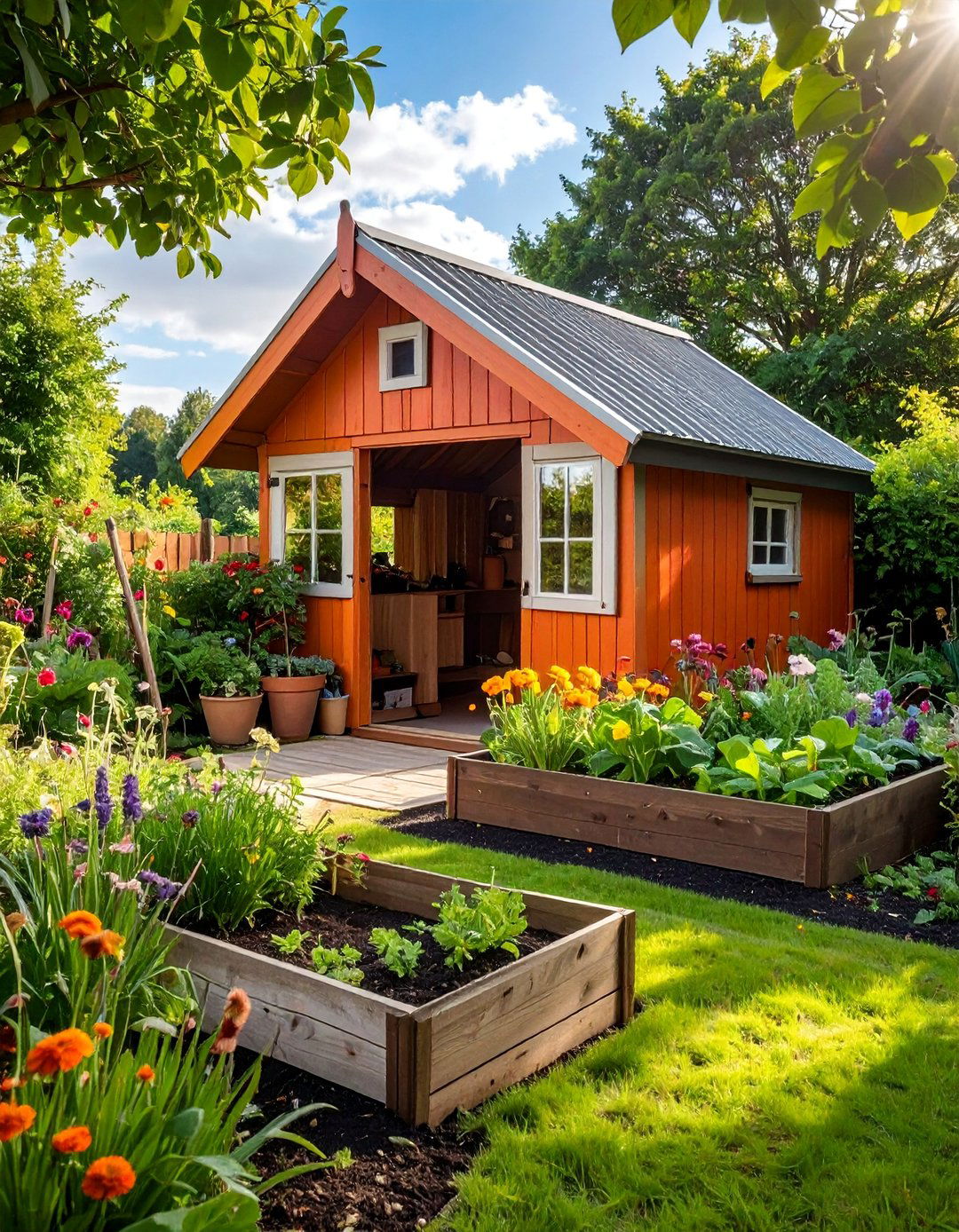
Create a functional work area featuring a potting shed or garden building surrounded by appropriate plantings that support gardening activities while maintaining aesthetic integration with the overall garden design. Include raised beds and container growing areas adjacent to the work space that facilitate easy plant care while creating attractive displays of vegetables, herbs, and flowers. Design storage systems that accommodate tools, materials, and seasonal equipment while maintaining organized and attractive work environments. Include compost areas and other utilitarian features that support sustainable gardening practices while being appropriately screened or integrated into the landscape design. Plan for seasonal workflow patterns that accommodate intensive gardening activities while preserving the beauty of surrounding garden areas. Include climber-covered structures and decorative elements that soften utilitarian buildings while providing additional growing space for ornamental and productive plants. This approach creates fully functional gardening areas that enhance rather than detract from overall garden beauty while providing essential support for intensive garden management.
38. Traditional Knot Garden
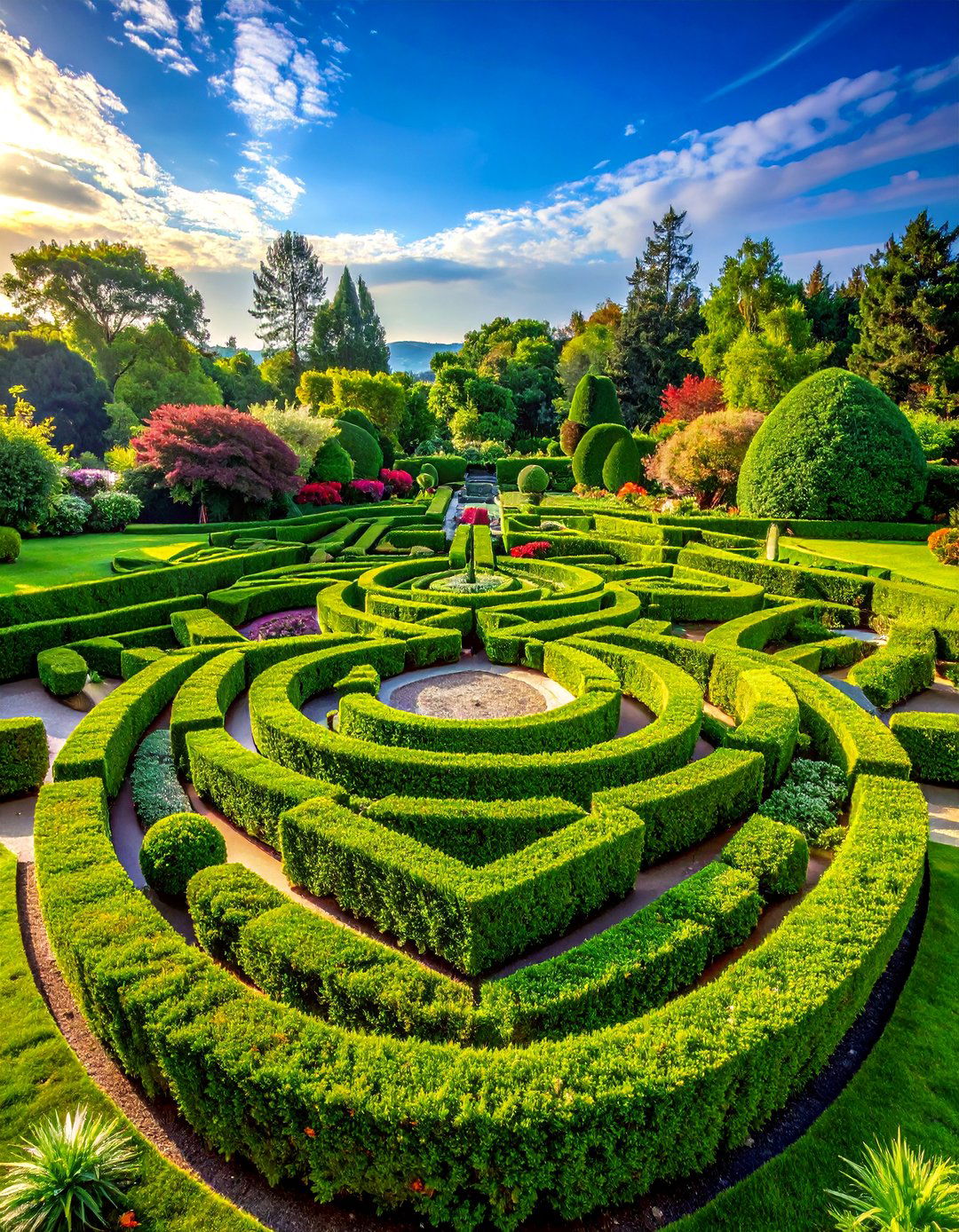
Create an intricate formal garden featuring low hedging plants arranged in interwoven patterns that demonstrate historical garden design techniques while providing year-round structural beauty. Use traditional plants such as boxwood, germander, or santolina that maintain crisp edges through regular trimming while providing different colors and textures within the geometric patterns. Include gravel or seasonal plantings within the enclosed areas that highlight the hedge patterns while providing color and interest during different seasons. Design pathways that allow viewing and maintenance access while preserving the formal character of the knot design. Include central focal points such as sundials, statuary, or topiary specimens that anchor the design while providing vertical interest. Plan for intensive maintenance requirements including regular trimming, edge refinement, and seasonal planting changes that preserve the garden's formal character. This approach requires significant expertise and ongoing attention but creates garden features of historical significance while demonstrating advanced horticultural skills and providing year-round structural beauty.
39. Perennial Cutting Border
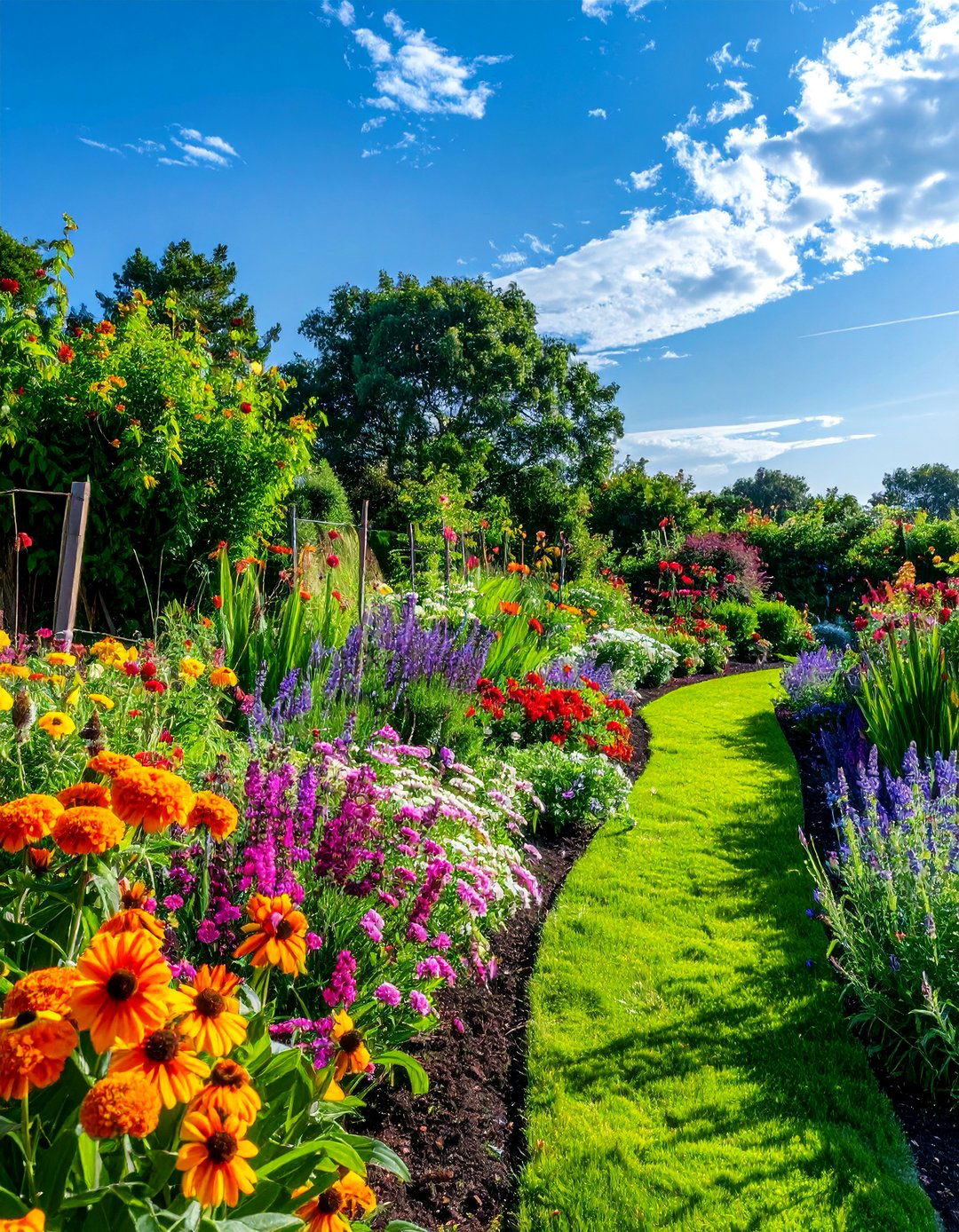
Design specialized borders that provide abundant flowers for cutting while maintaining ornamental value within the garden through careful plant selection and layout planning. Include plants that respond well to cutting by producing more flowers while choosing varieties that provide good stem length and vase life for indoor arrangements. Plan for succession plantings and multiple sowings that ensure continuous flower production throughout the growing season. Include both annual and perennial flowers that provide different seasonal peaks while maintaining overall border beauty even when flowers are regularly harvested. Design adequate pathways that facilitate easy cutting access while providing space for maintenance activities and border appreciation. Include support systems for tall-growing flowers that maintain both plant health and border appearance while facilitating harvest activities. This approach requires regular attention and seasonal planning but provides enormous satisfaction through its productivity while creating borders that enhance both indoor and outdoor beauty throughout the growing season.
40. English Manor House Entry
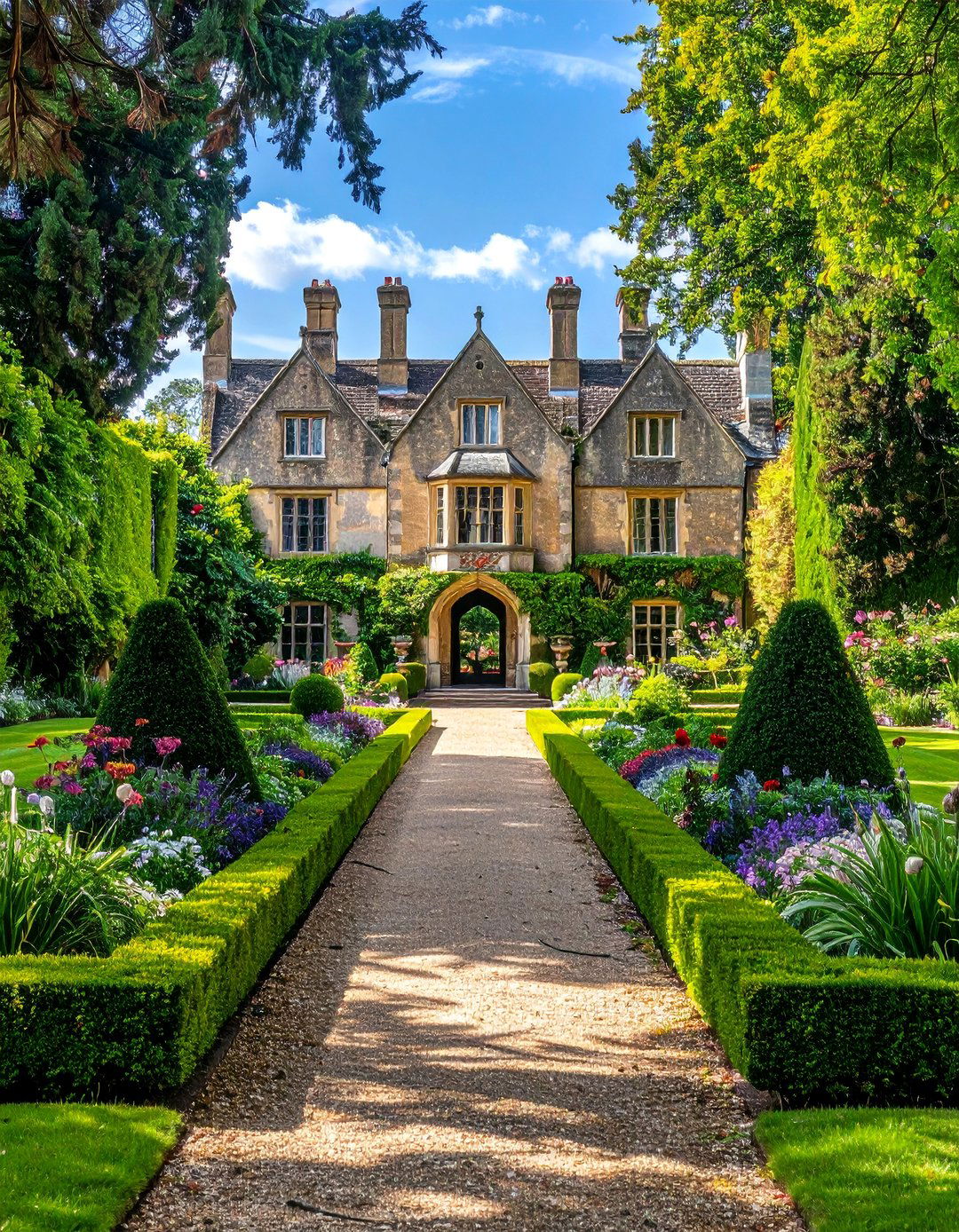
Create a grand entrance garden that reflects the formal elegance of English manor house grounds while adapting the concept for contemporary properties and smaller spaces. Include symmetrical plantings that frame the approach to the house while providing appropriate scale and seasonal interest throughout the year. Design formal elements such as clipped hedging, standard trees, or topiary specimens that create structural backbone while allowing for seasonal enhancement through flowers and foliage plants. Include quality hardscaping materials such as natural stone or brick that complement the architecture while providing permanent pathways and structural elements. Plan for dramatic focal points such as fountains, statuary, or formal plantings that create memorable impressions while reflecting the property's character and style. Include lighting elements that extend the garden's impact into evening hours while ensuring safe passage and highlighting key design features. This approach requires significant initial investment and ongoing maintenance but creates entrance gardens that provide lasting impressions while enhancing property value and demonstrating commitment to garden excellence.
Conclusion:
English garden design offers endless possibilities for creating landscapes that blend timeless beauty with practical functionality. These forty ideas demonstrate how traditional principles can be adapted to contemporary needs while maintaining the romantic character that makes English gardens so beloved worldwide. Whether you choose to implement formal parterre gardens with precise geometric patterns or embrace the wild abundance of cottage garden borders, success lies in understanding the relationship between structure and softness that defines this enduring style. The key is selecting designs that match your space, climate, and maintenance capabilities while respecting the core principles of layered planting, seasonal interest, and harmonious integration of built and natural elements. Remember that English gardens mature and improve with time, developing the settled character that makes them so appealing. Start with strong structural elements, choose plants suited to your conditions, and allow the garden to evolve naturally while maintaining its essential character through thoughtful care and occasional refinement.

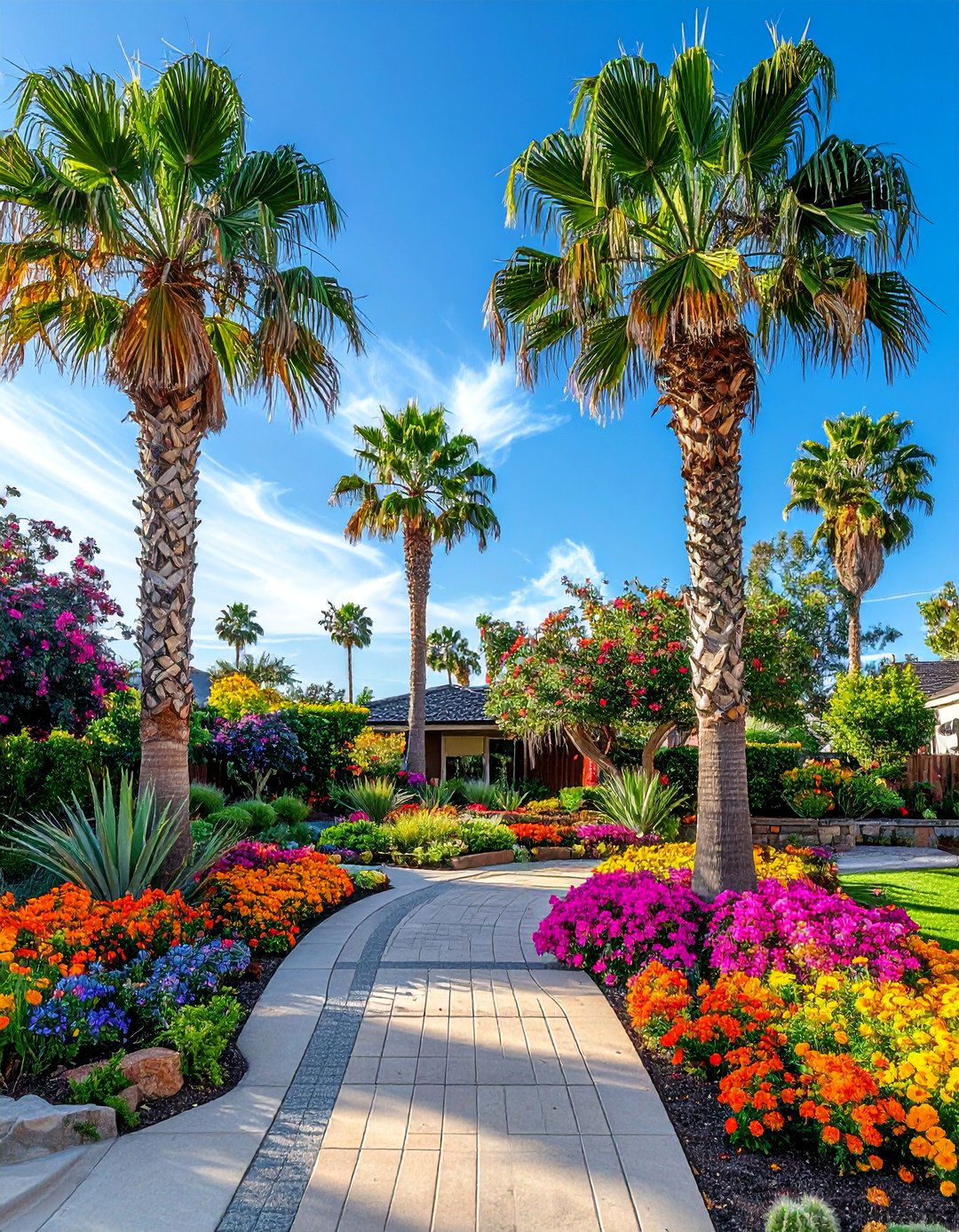
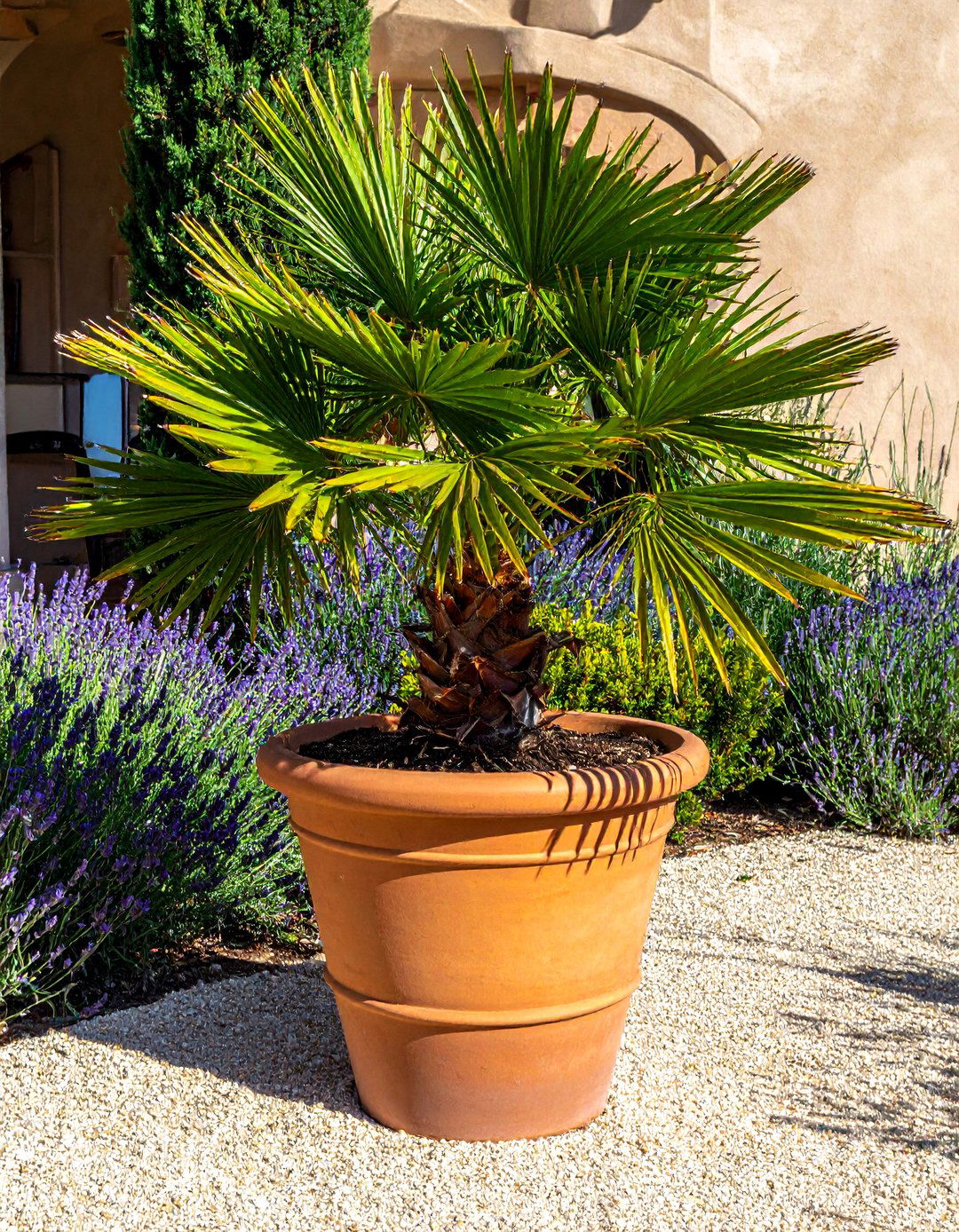
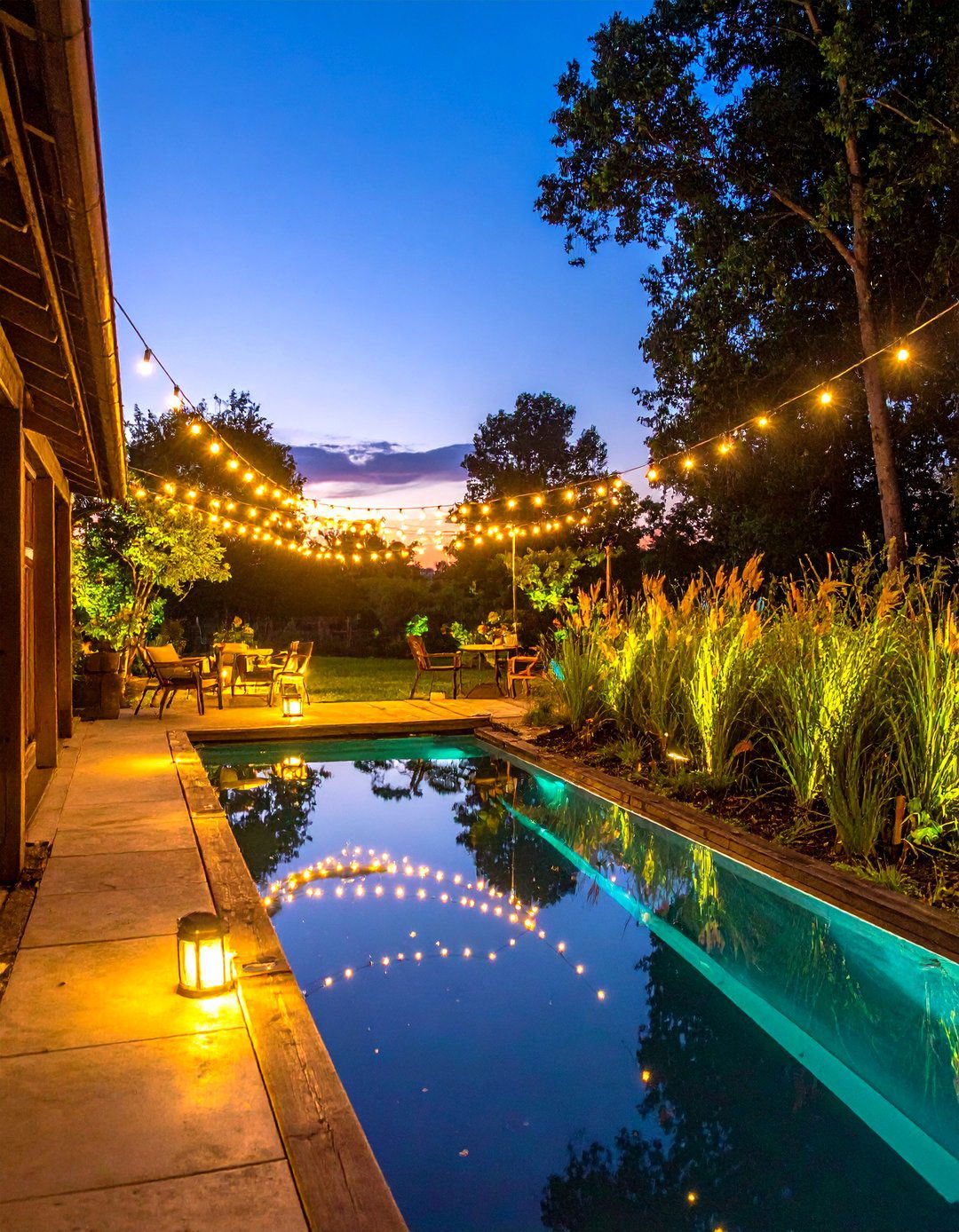
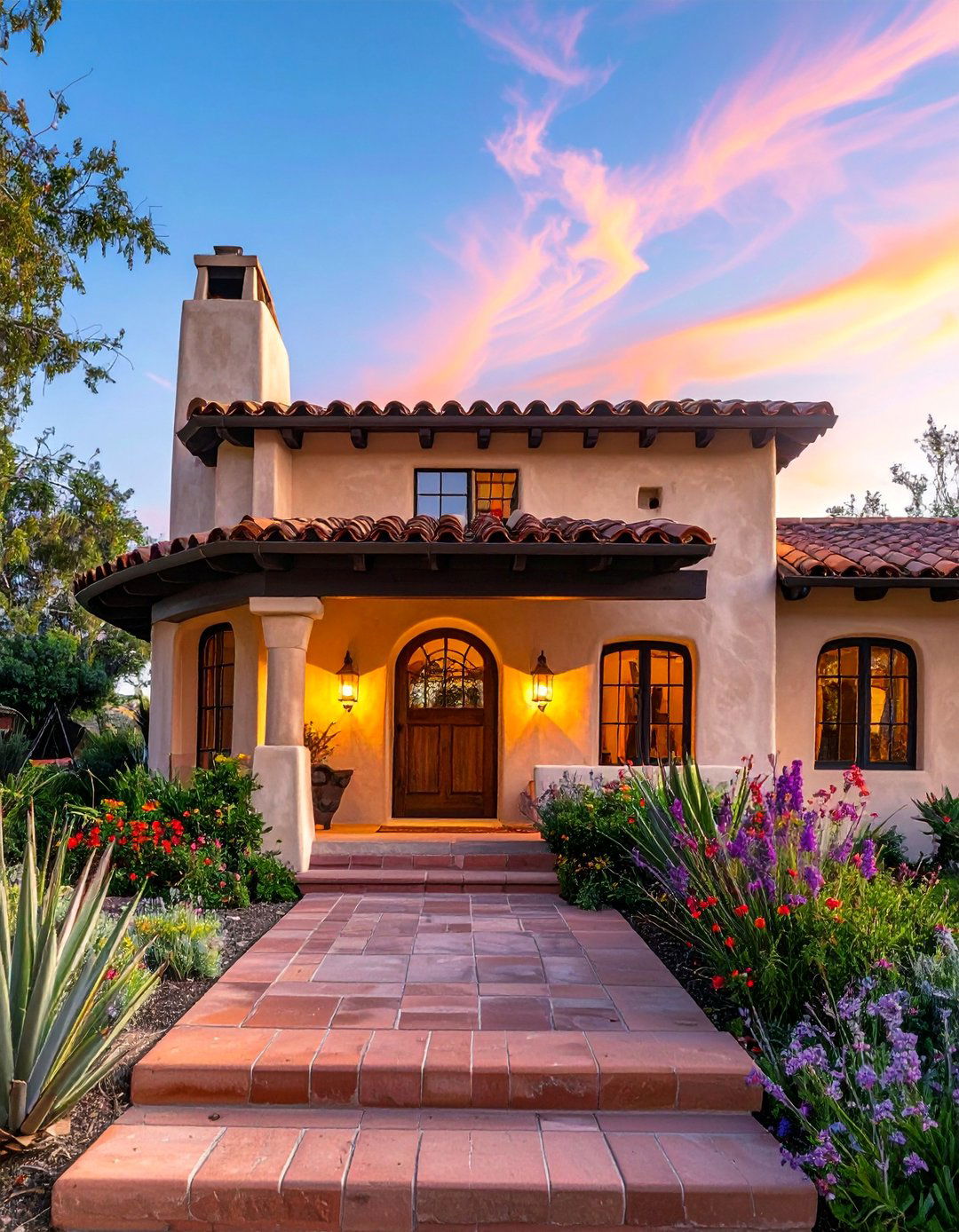
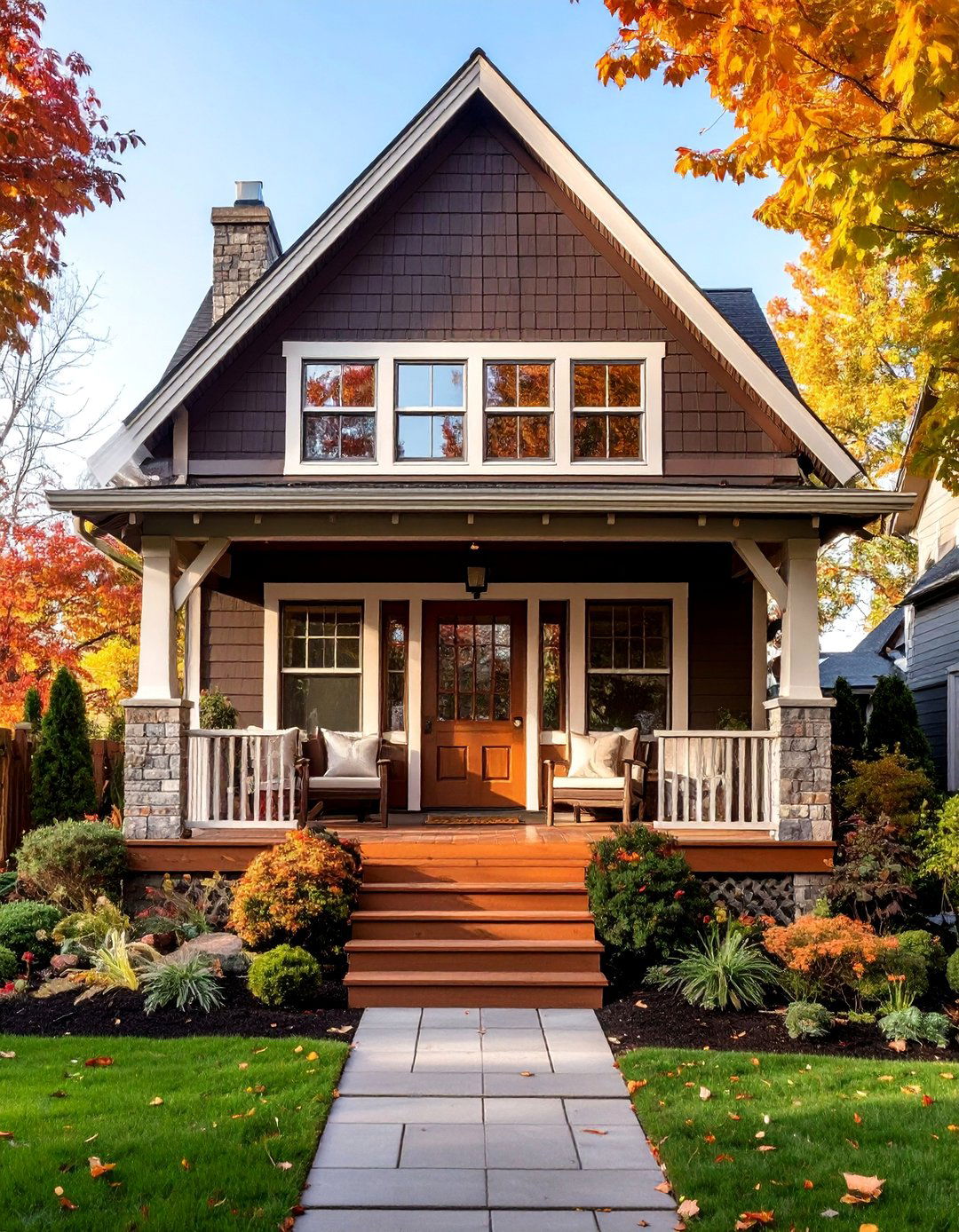
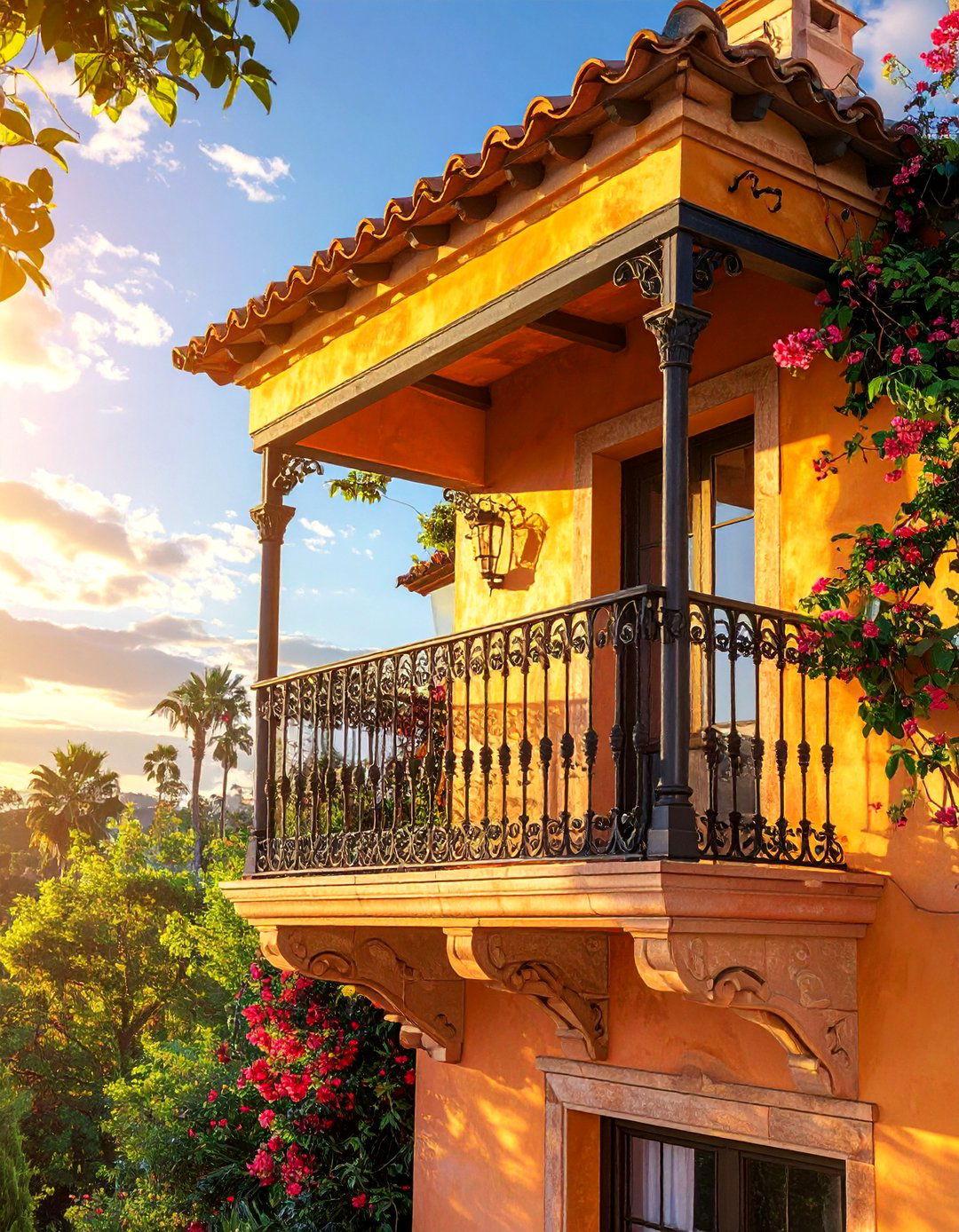
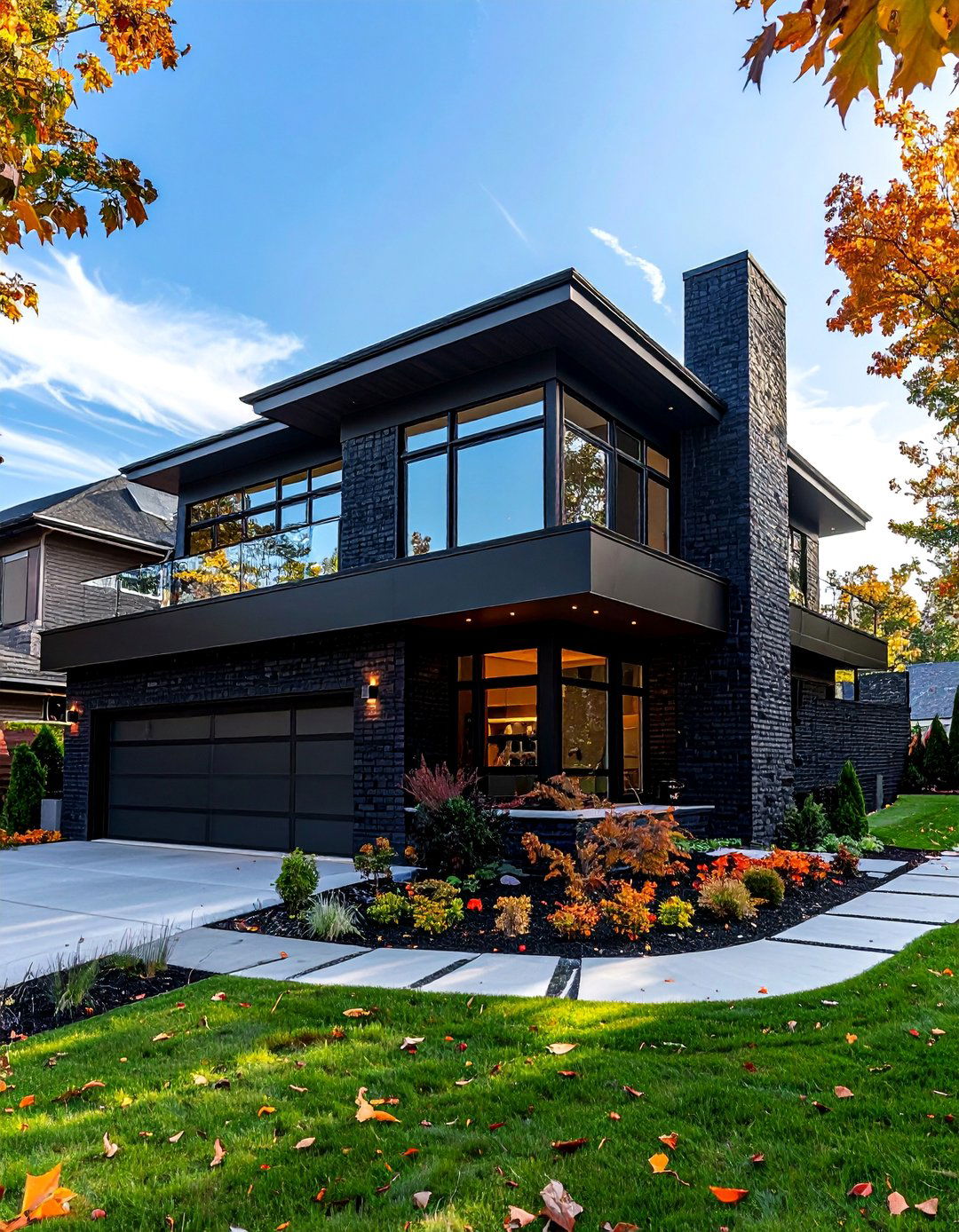
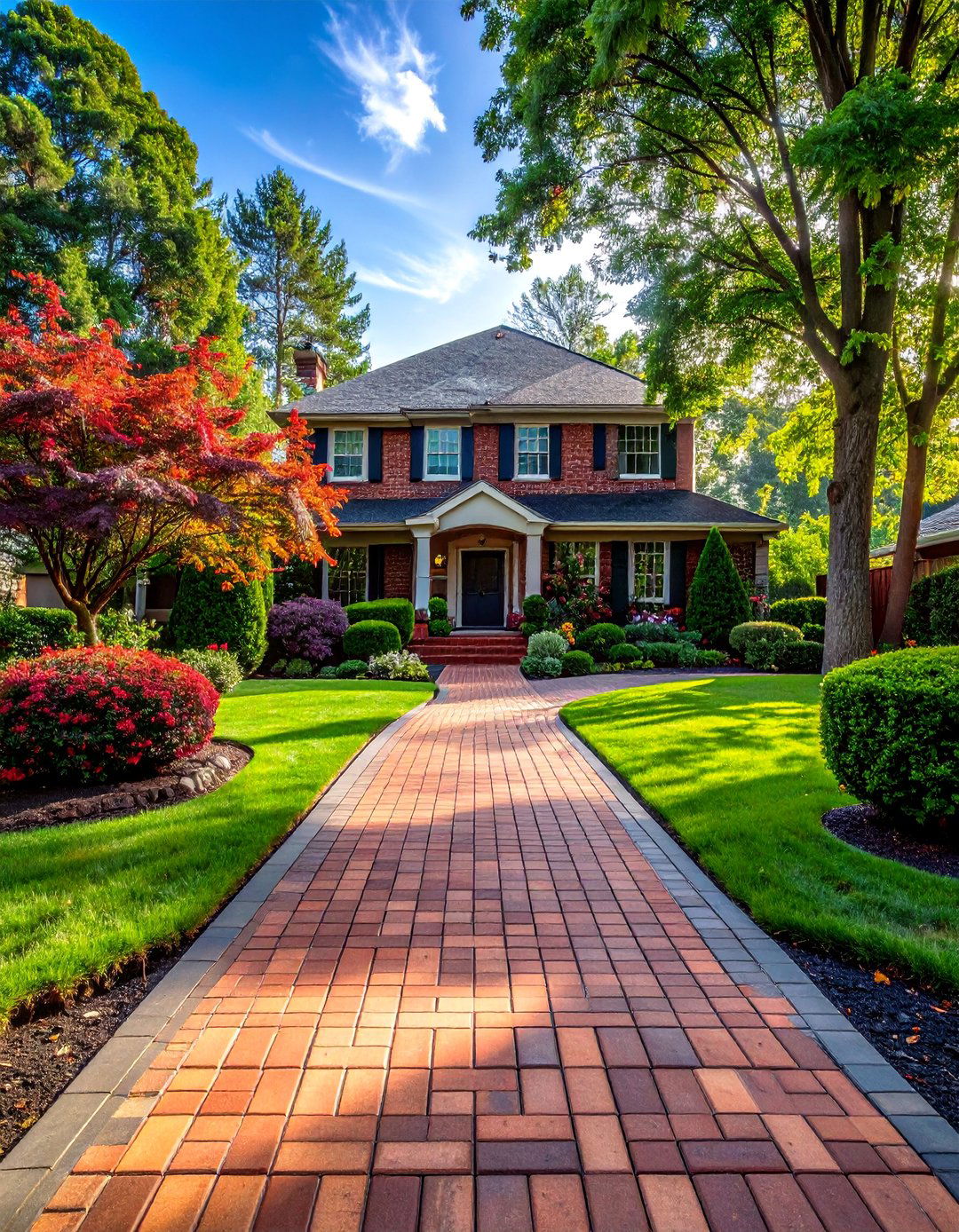
Leave a Reply